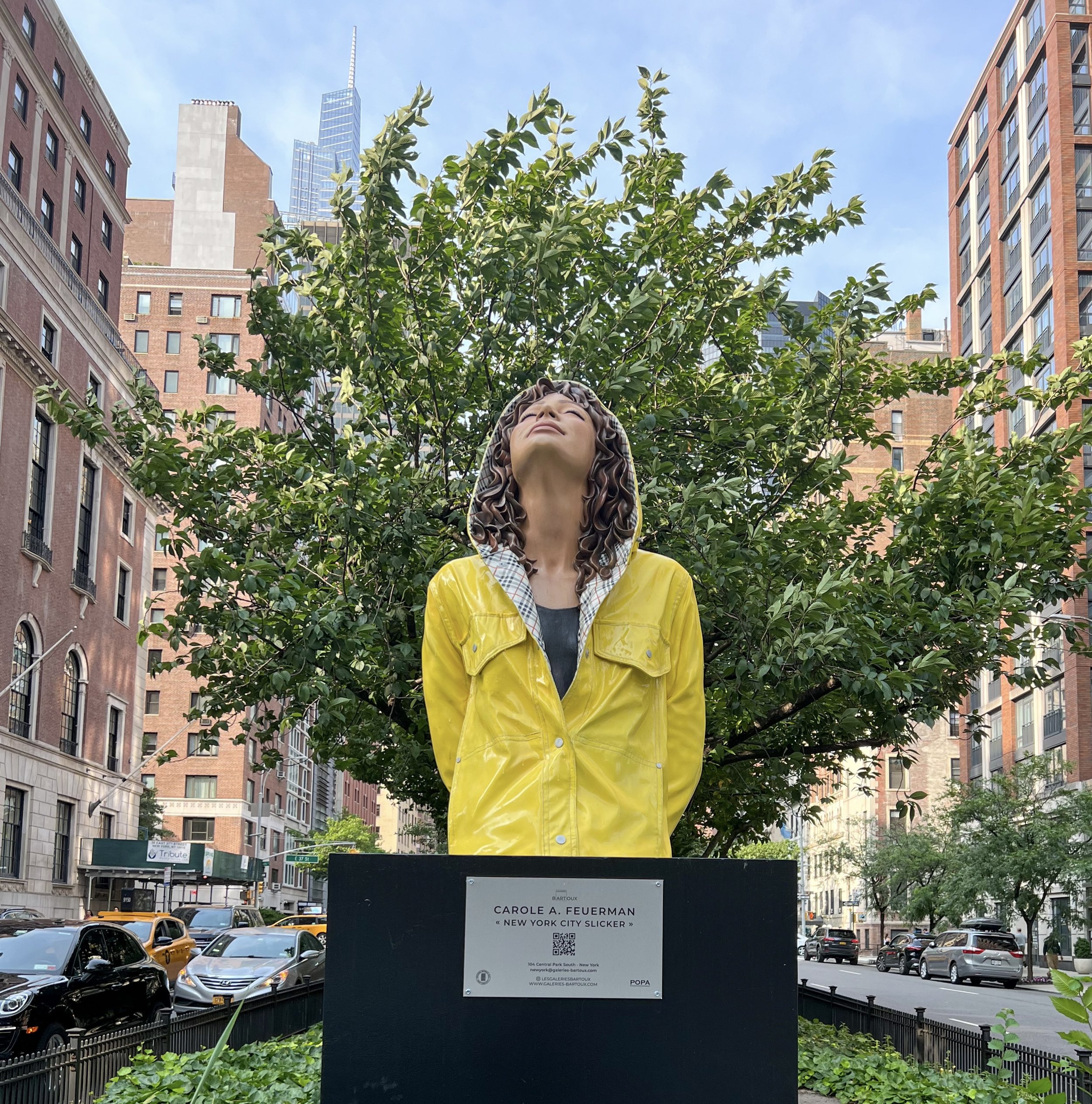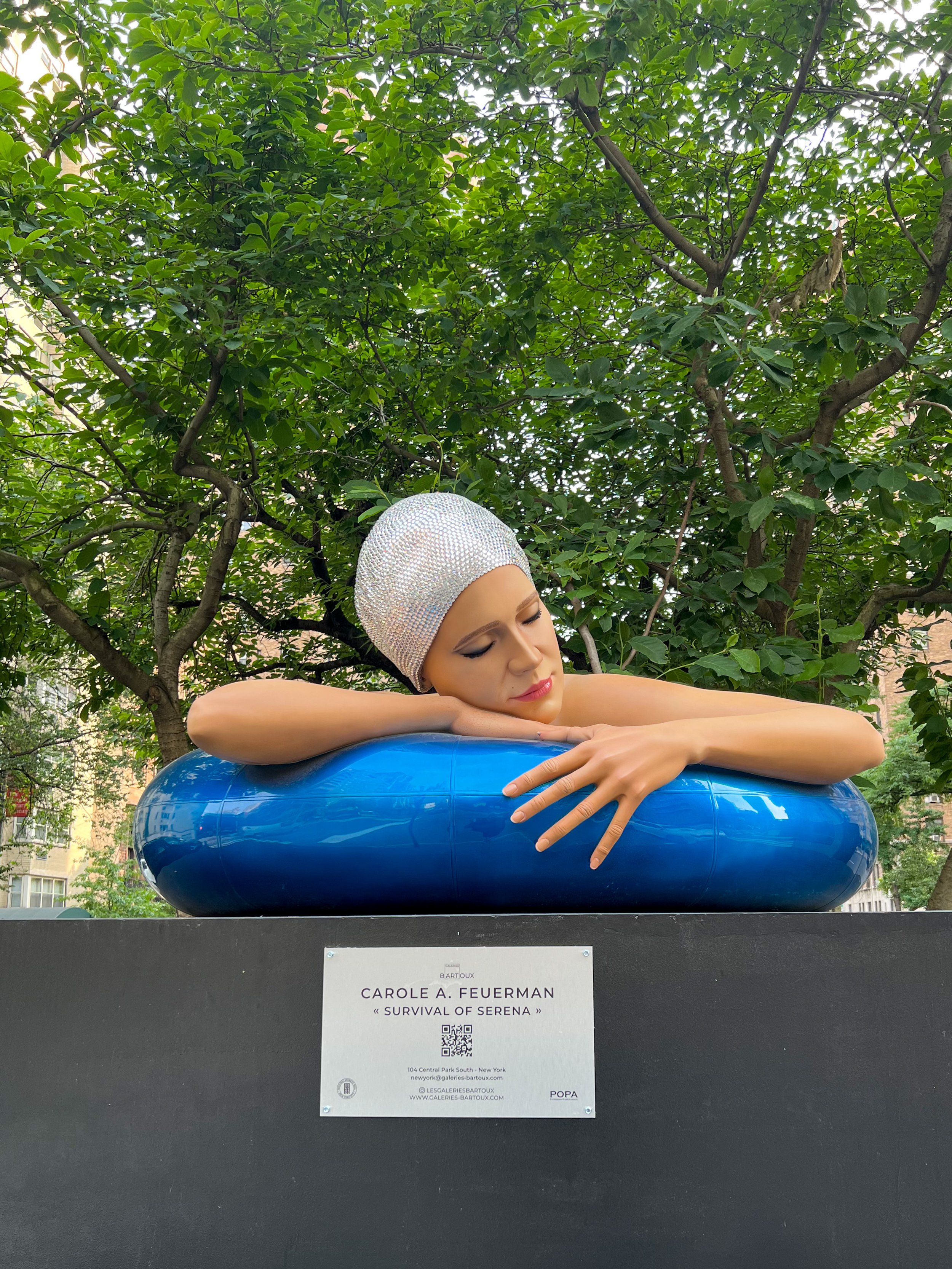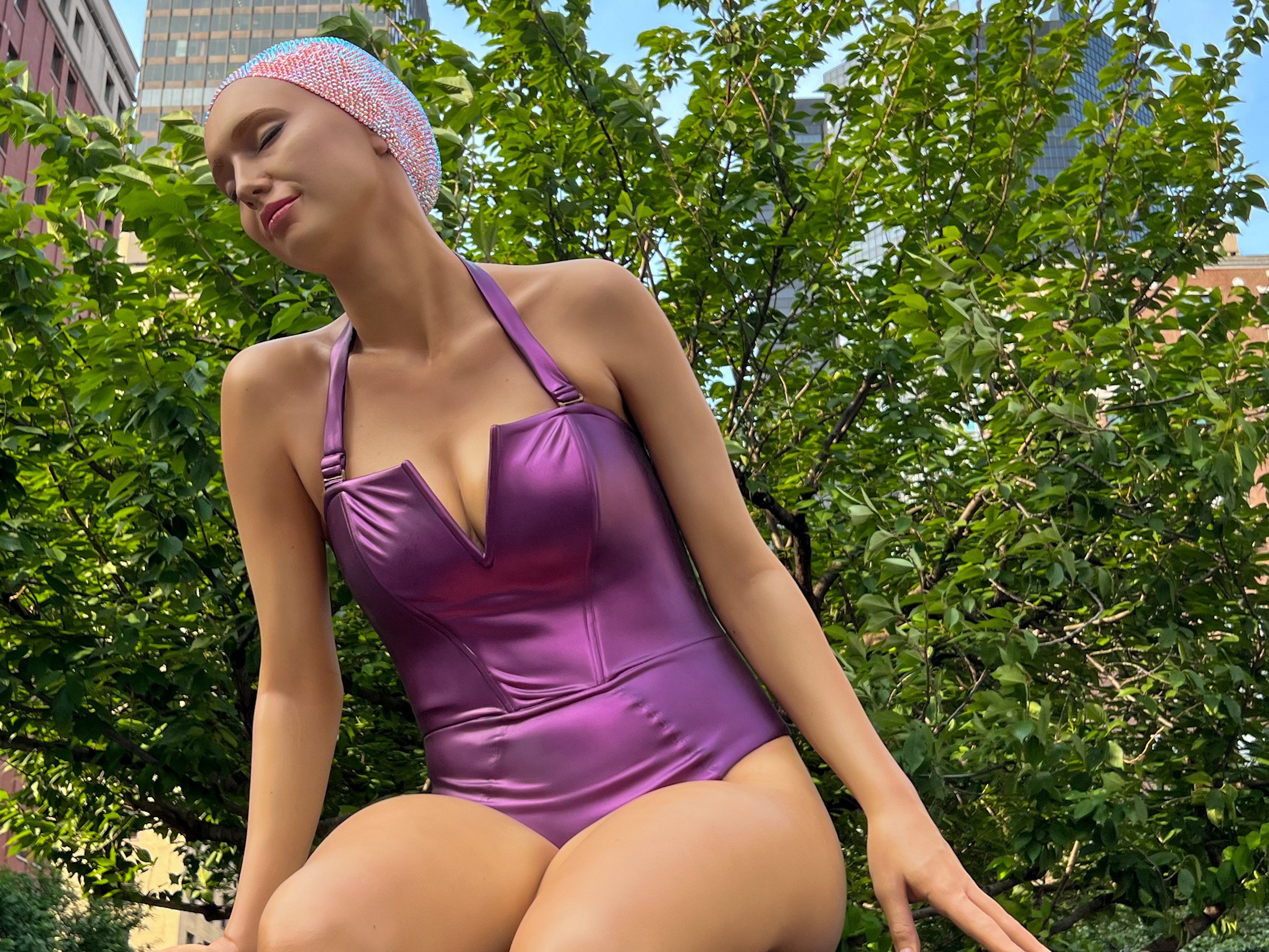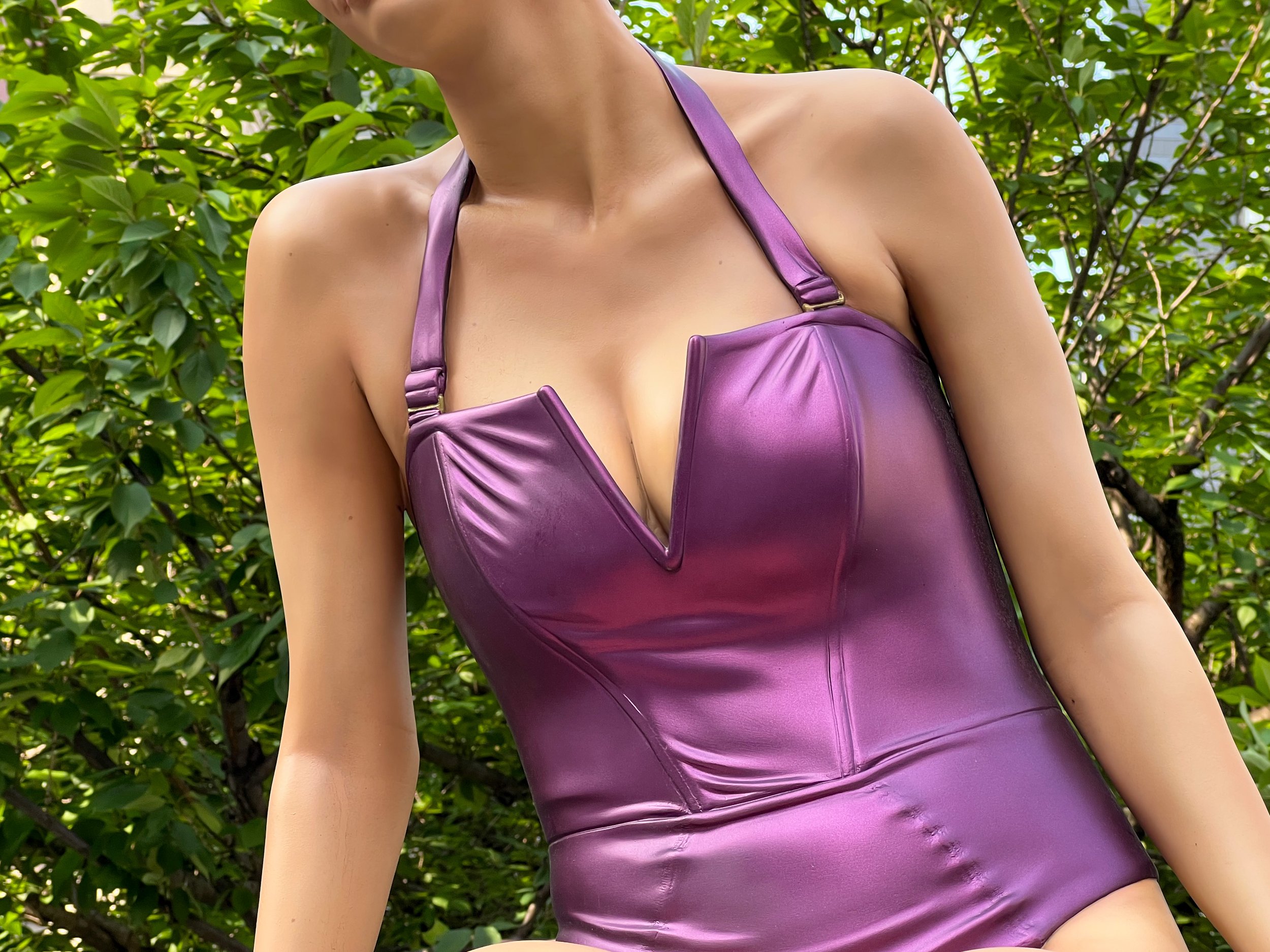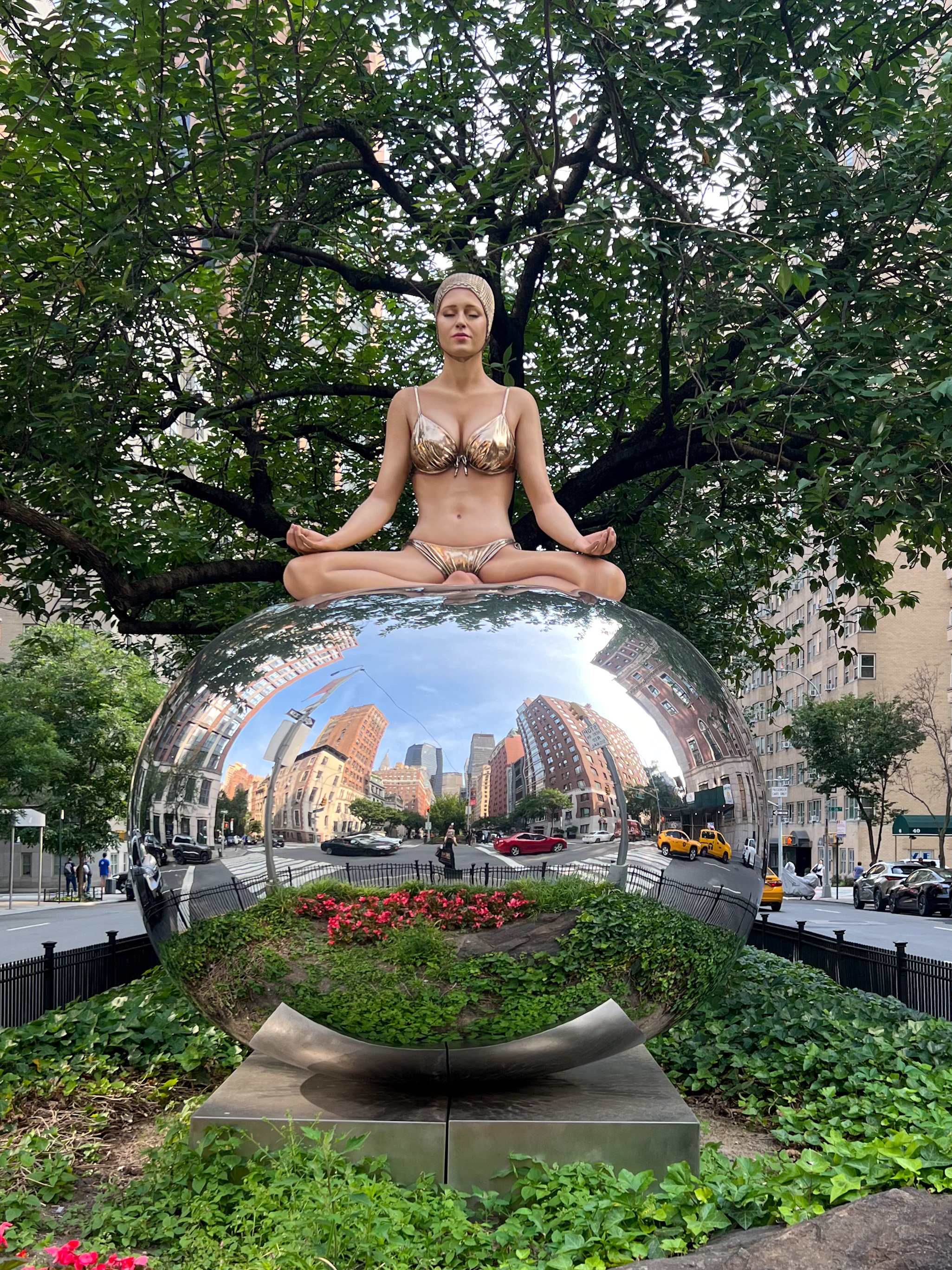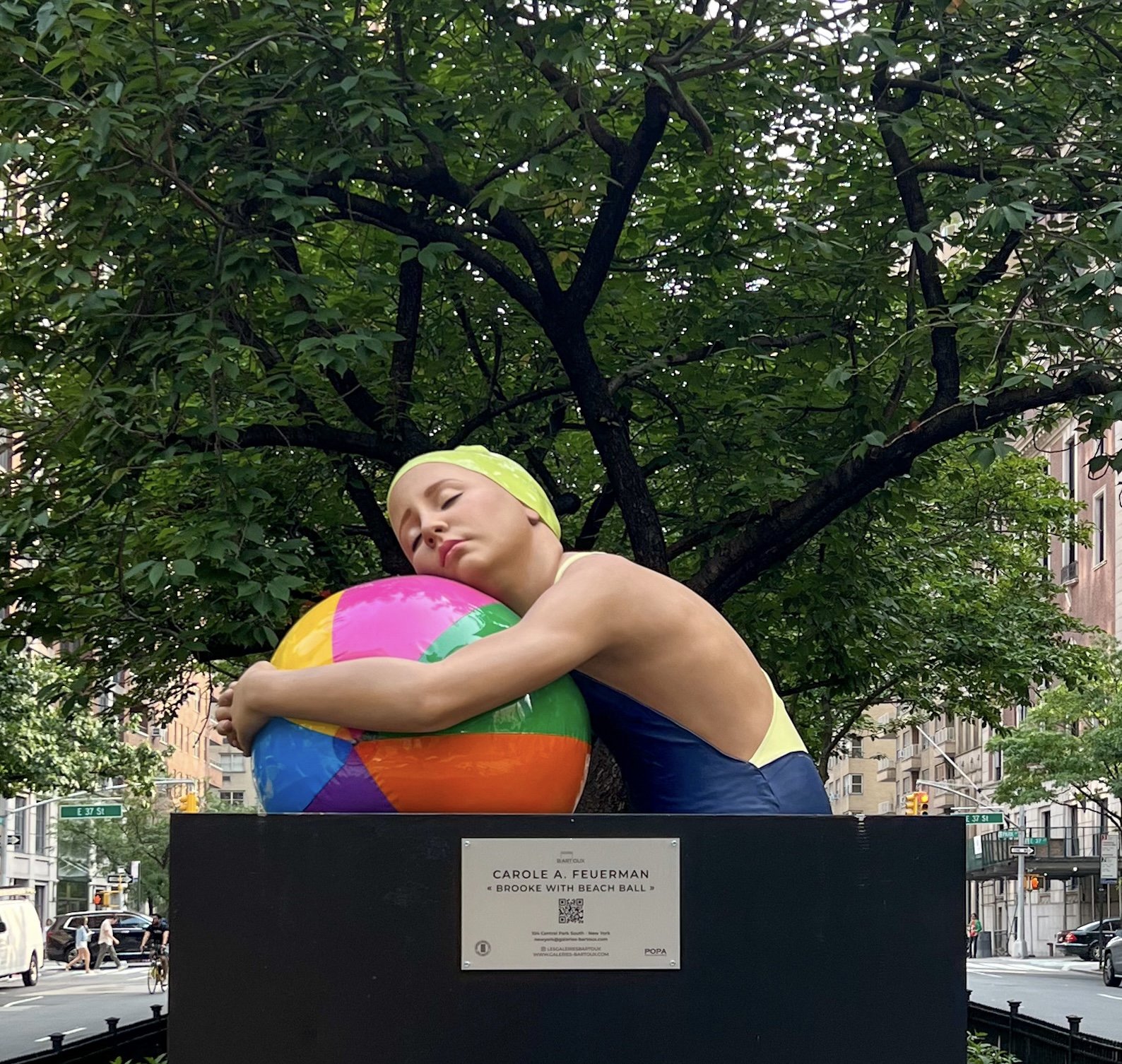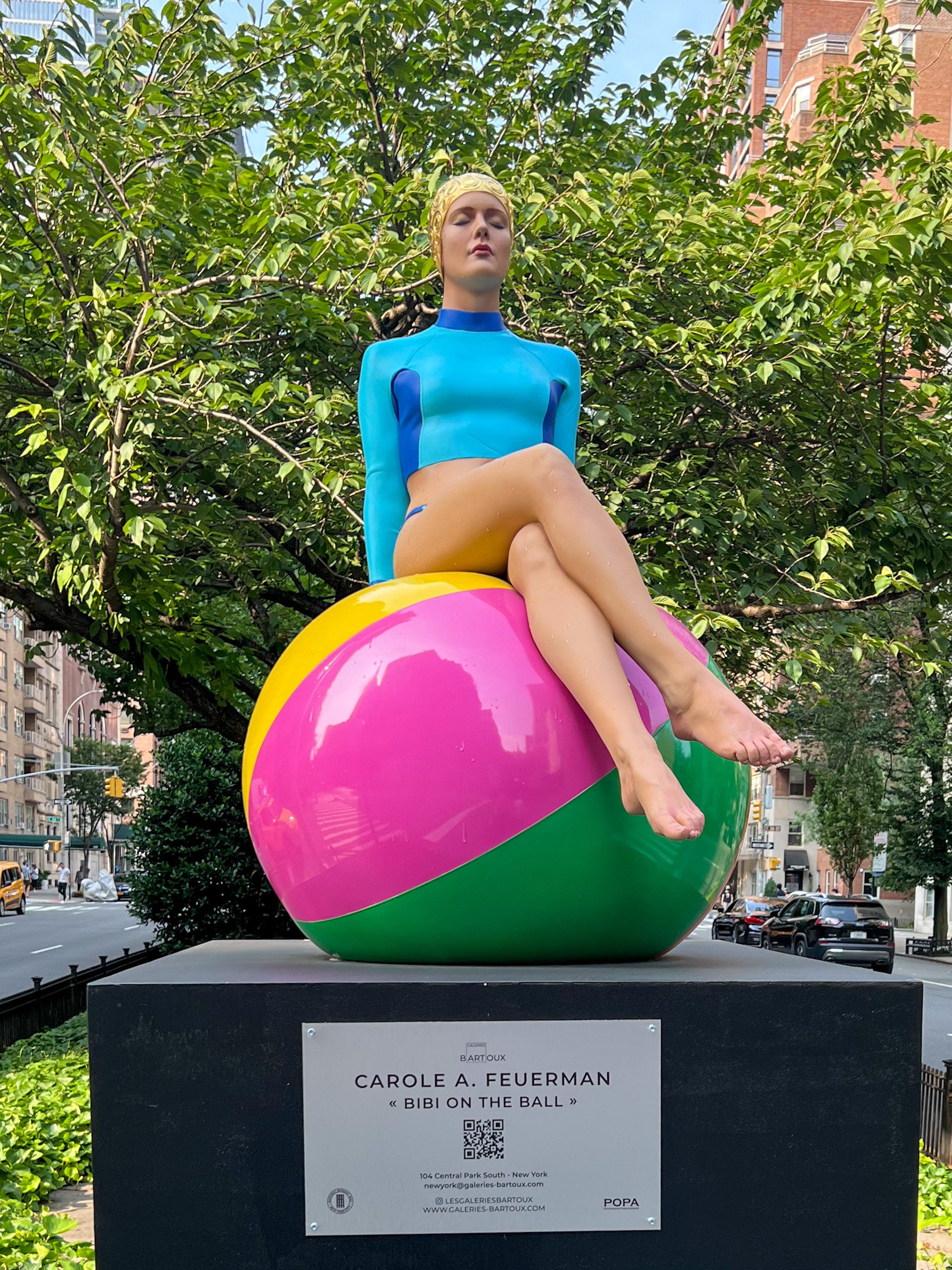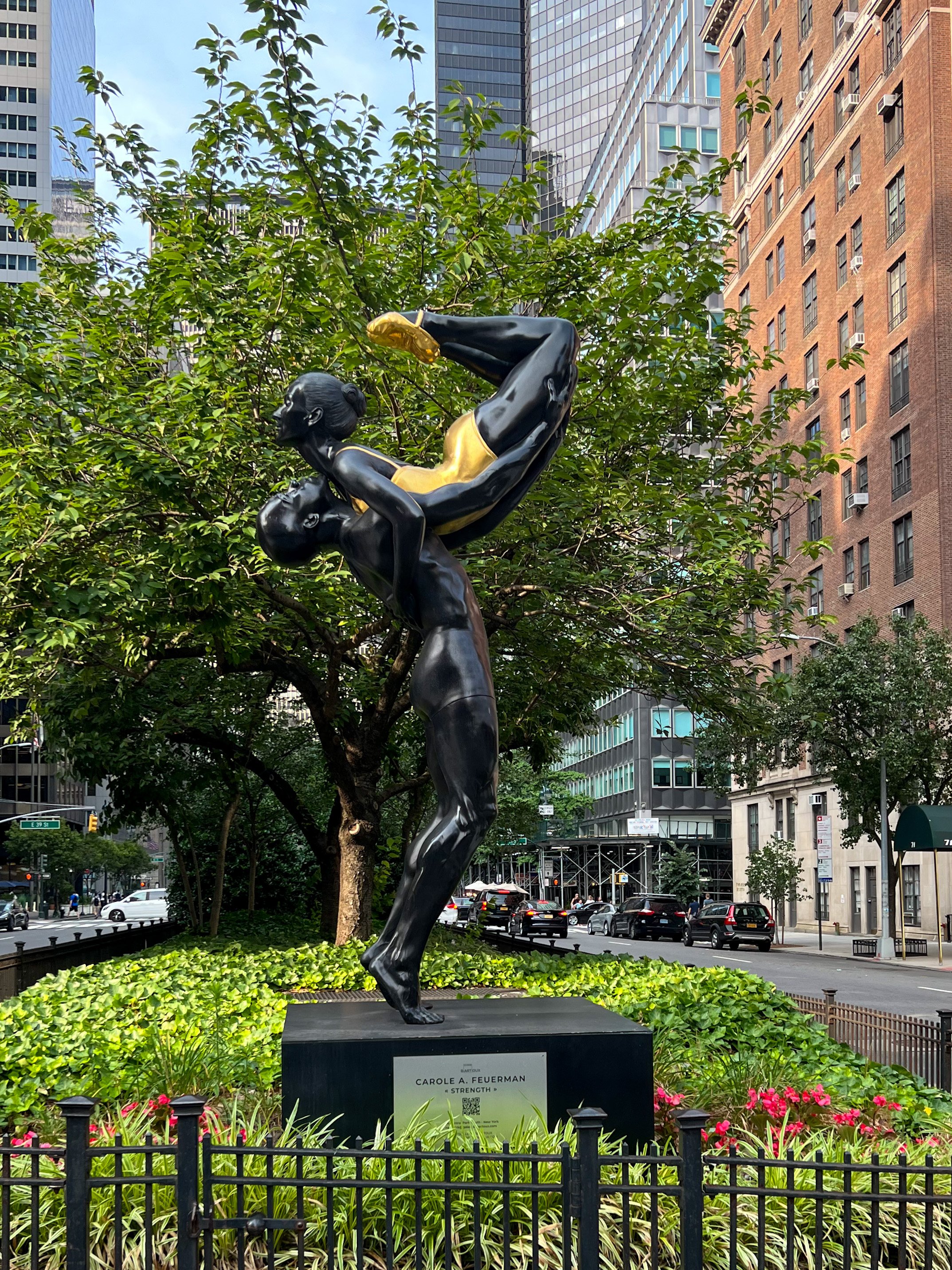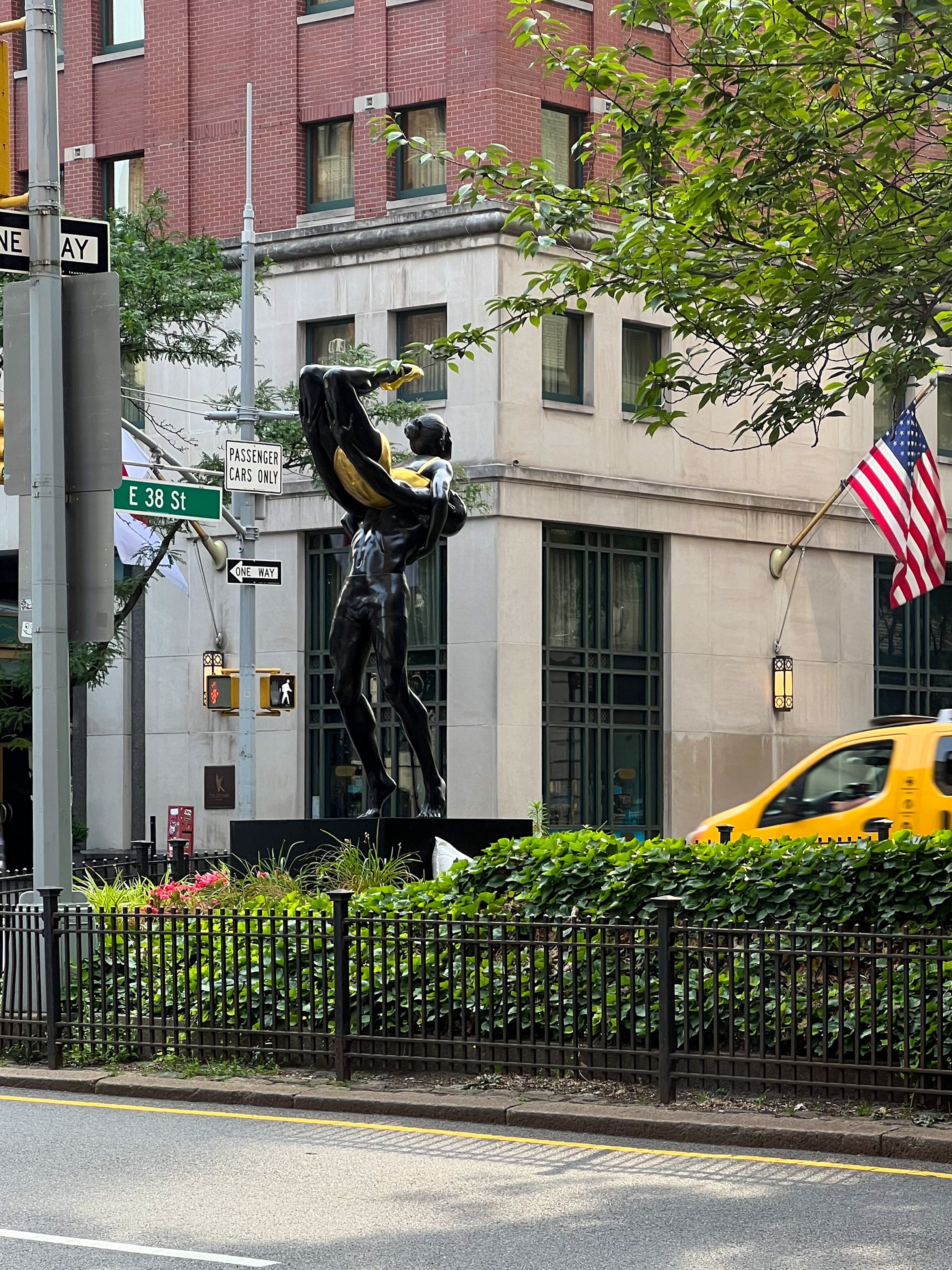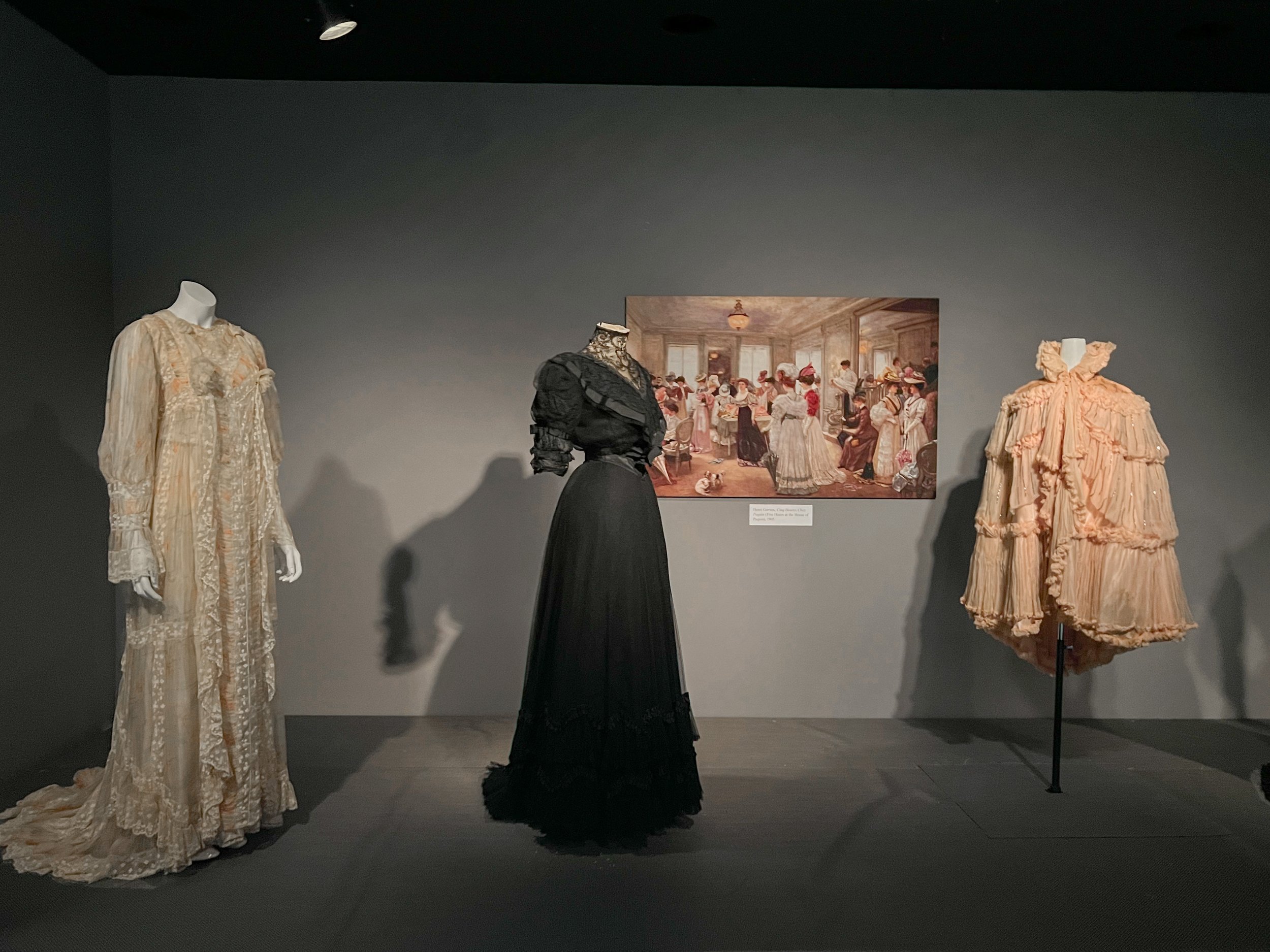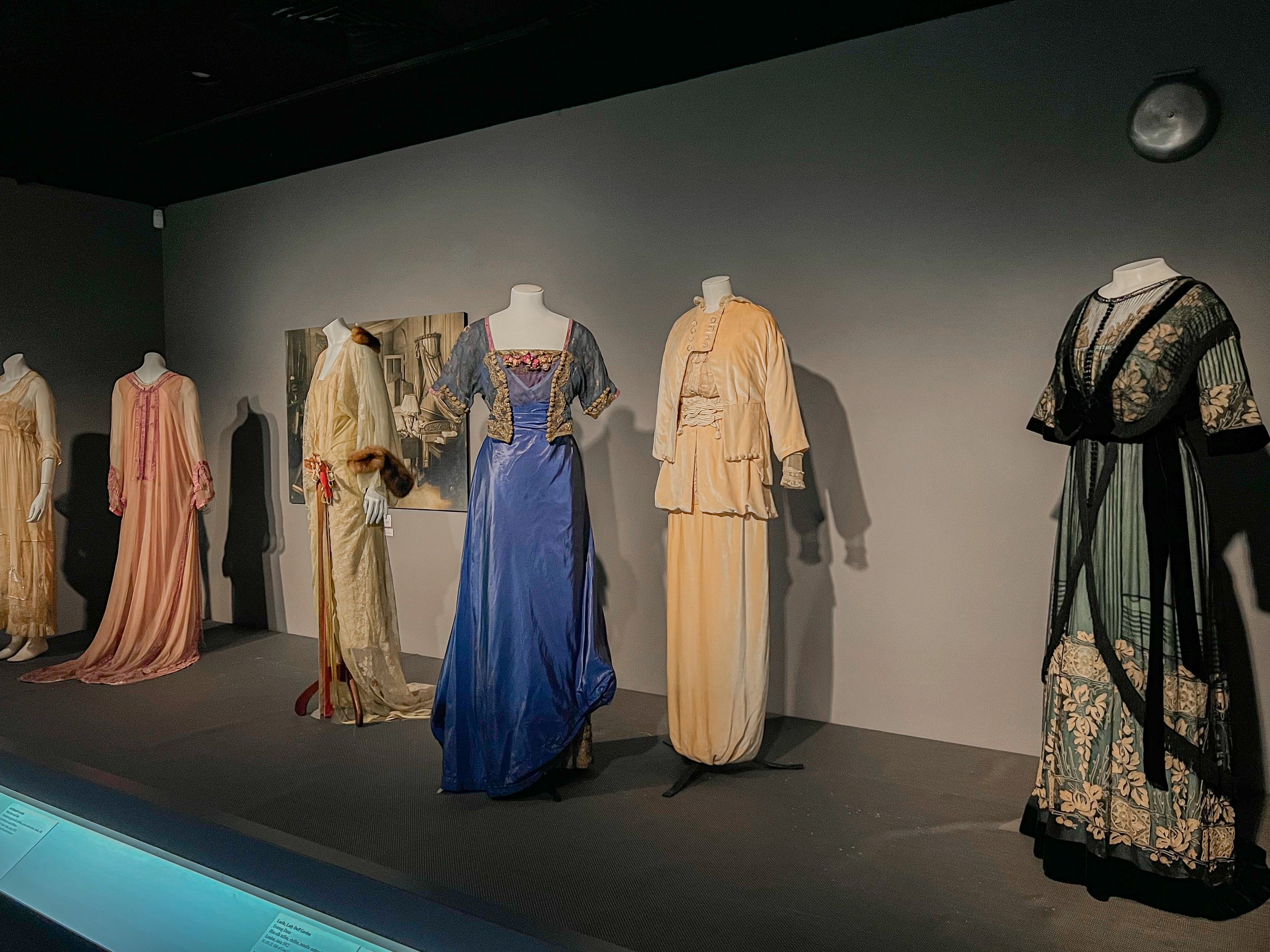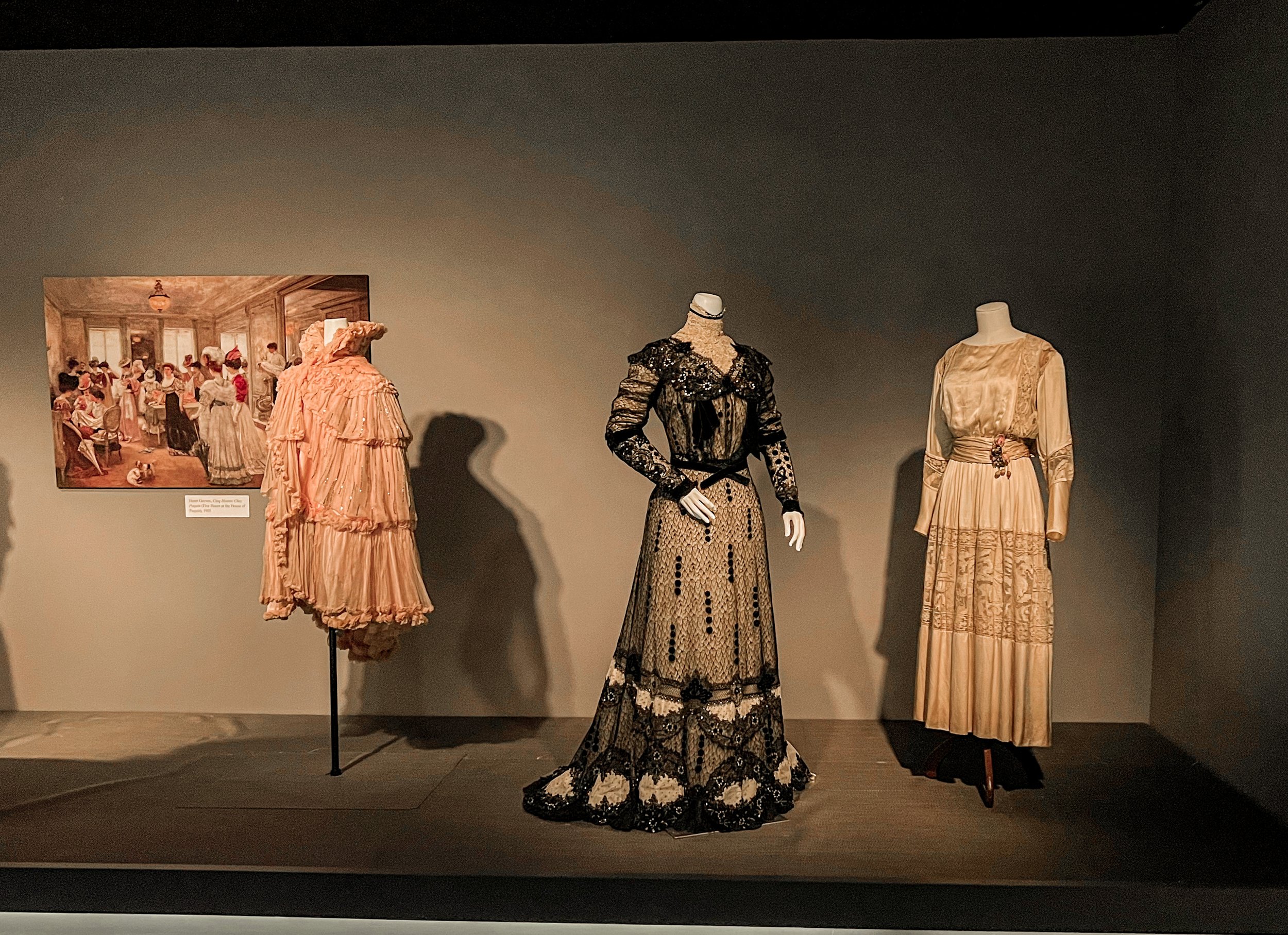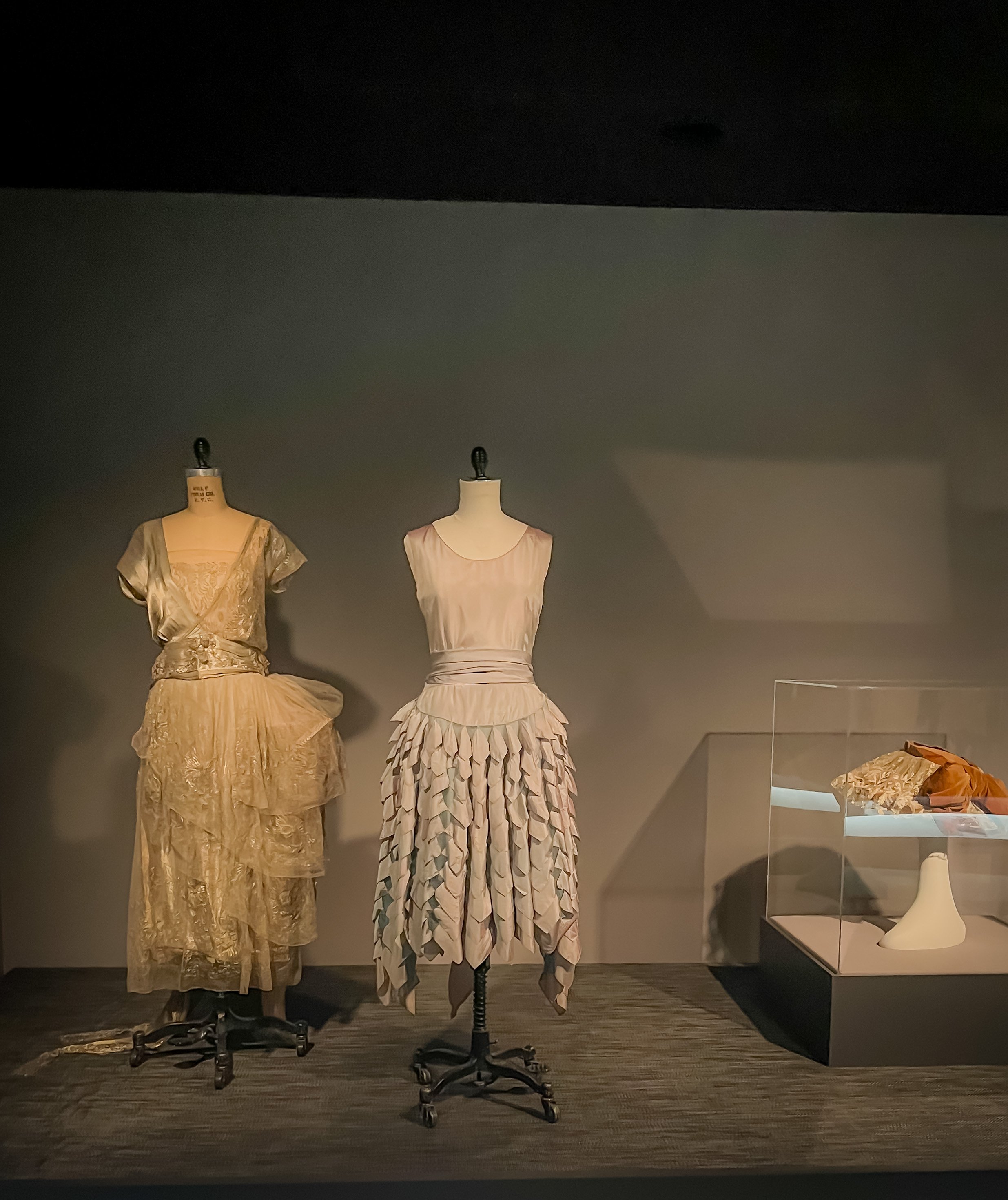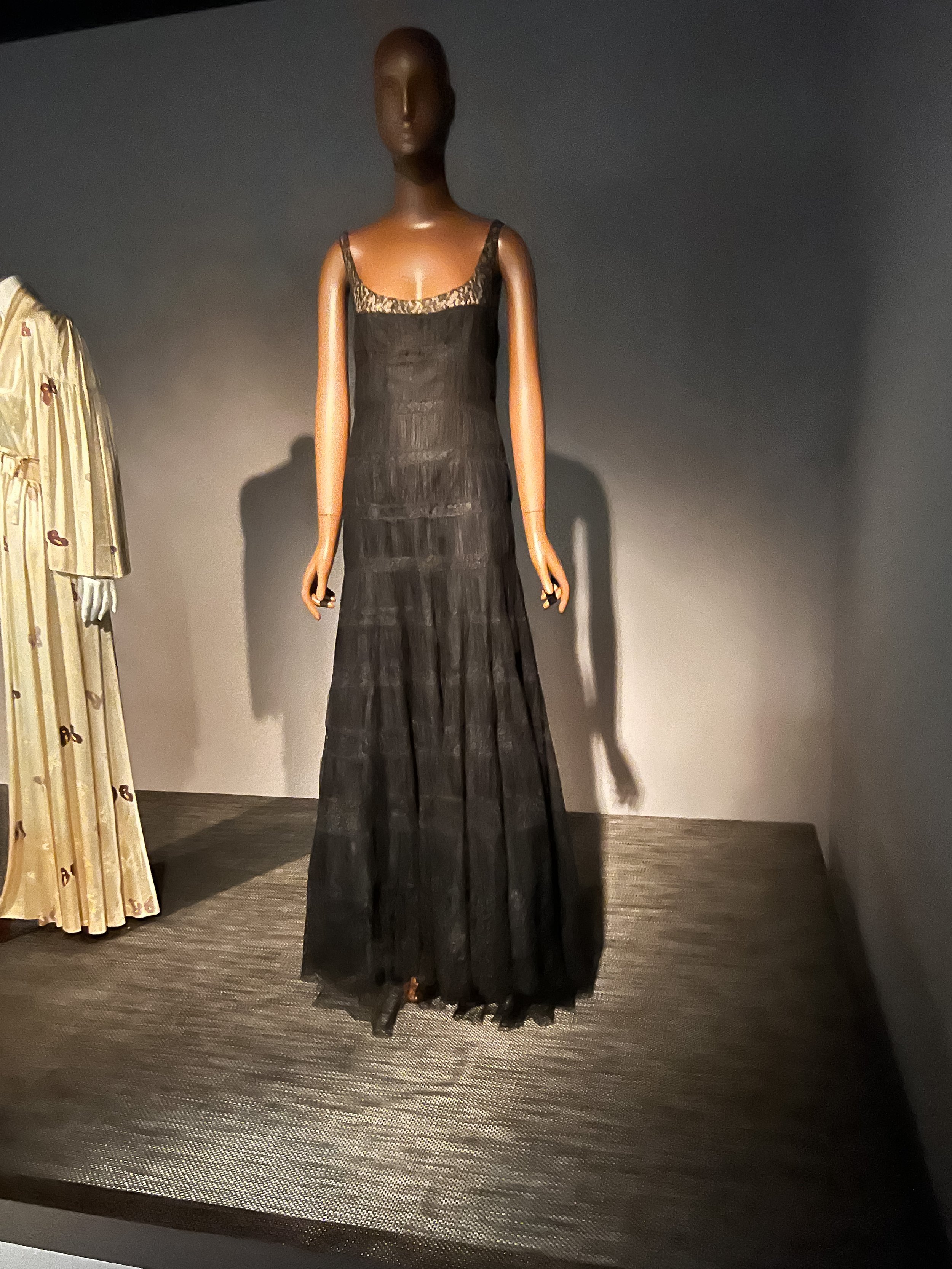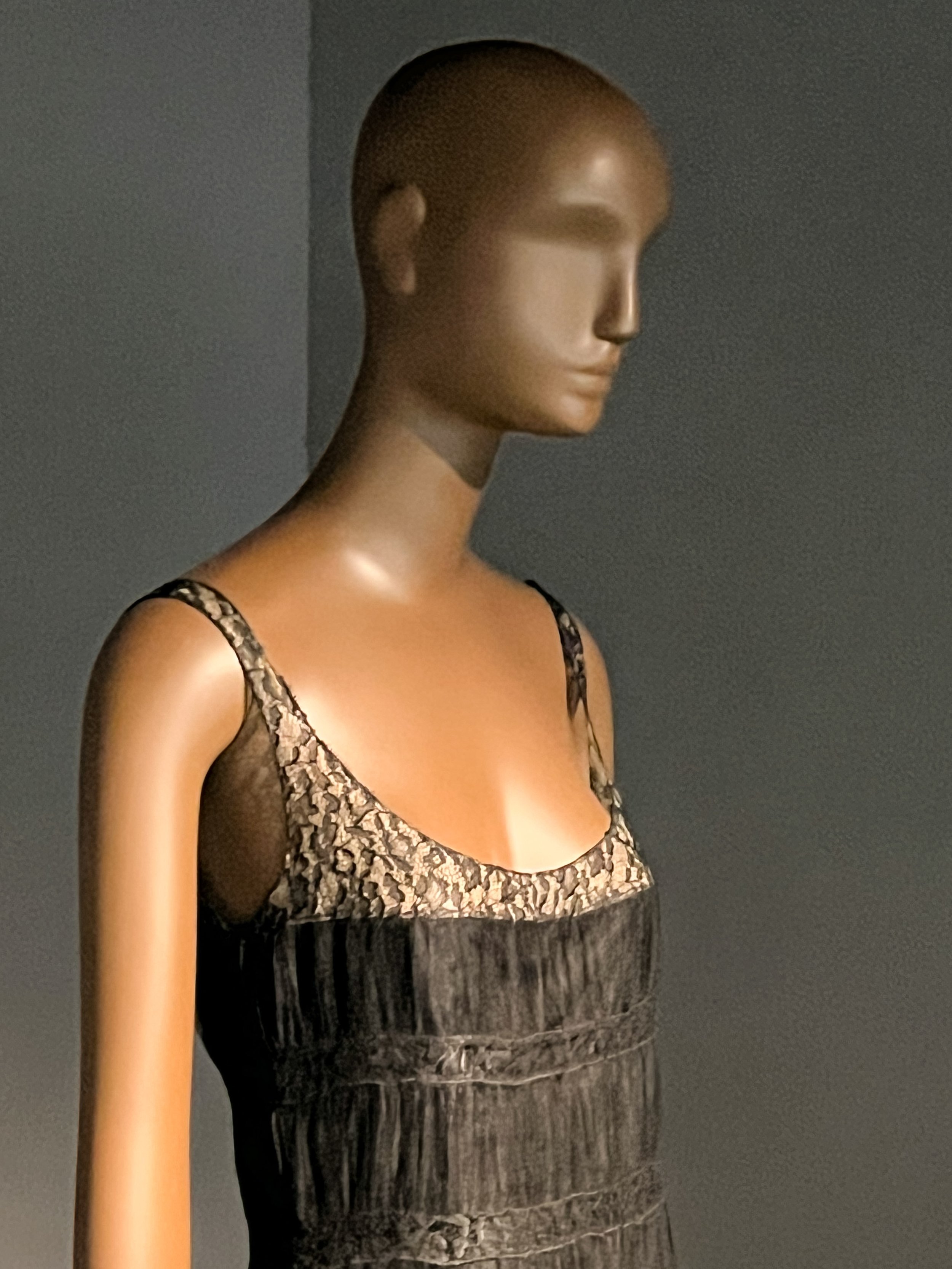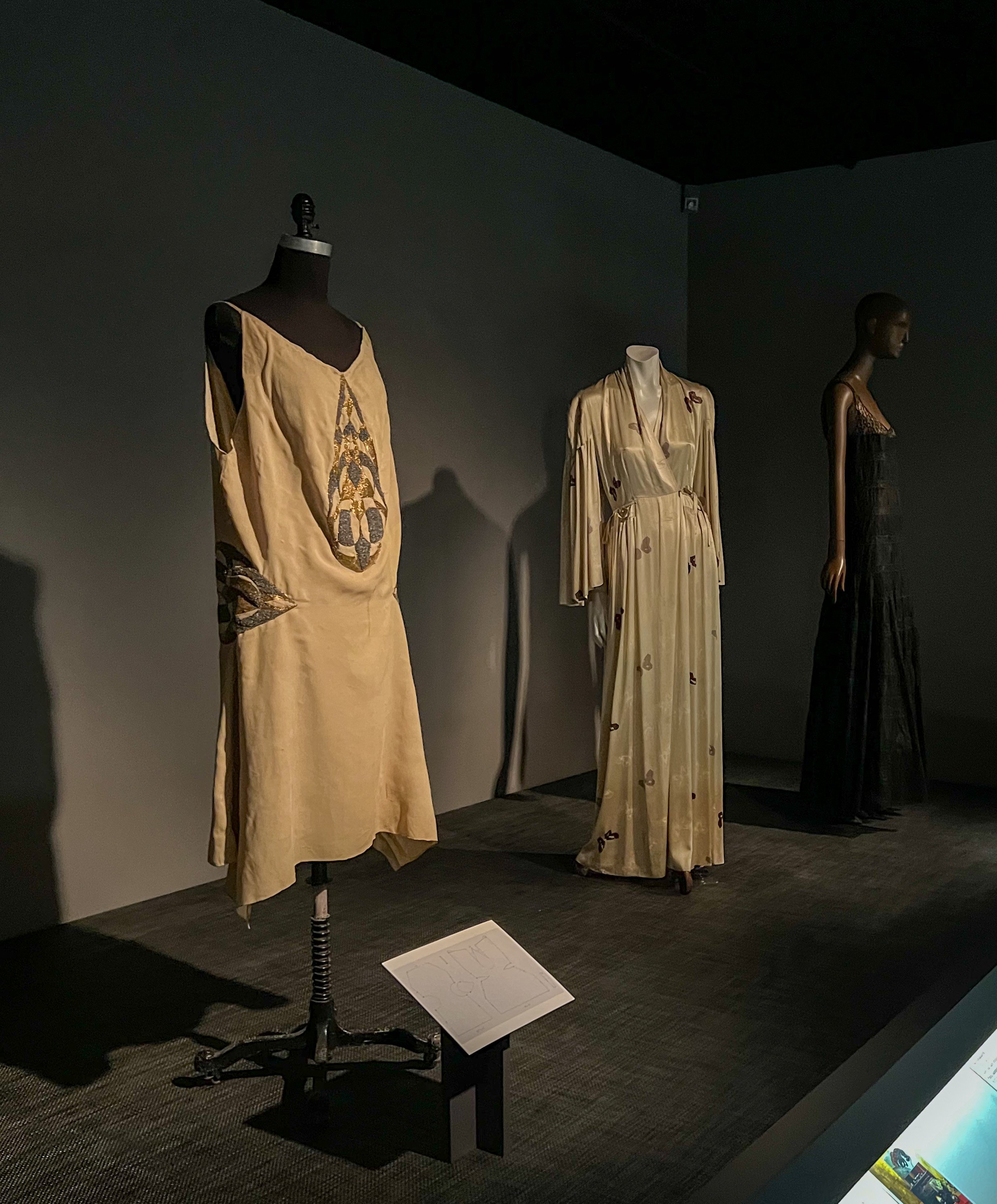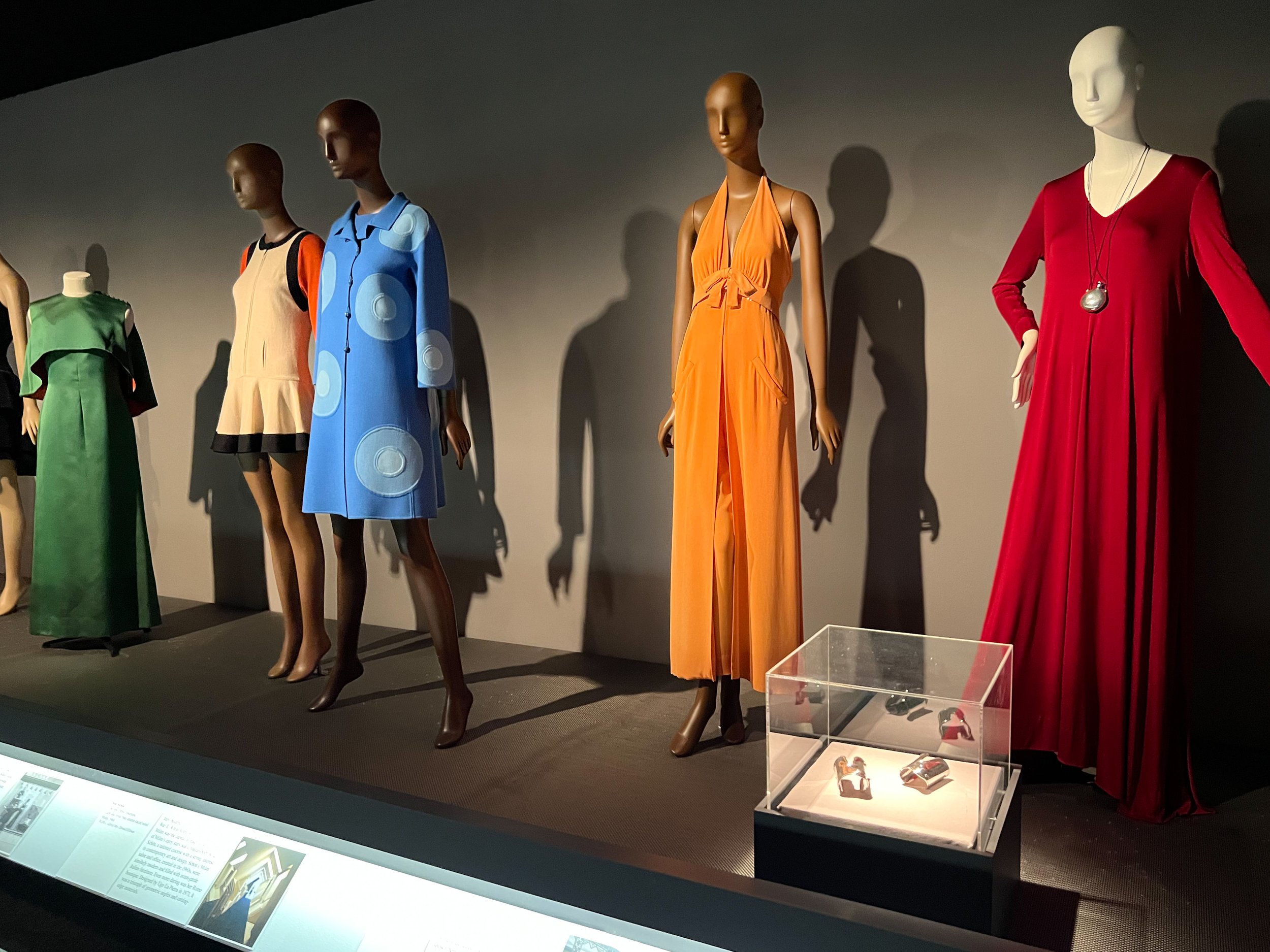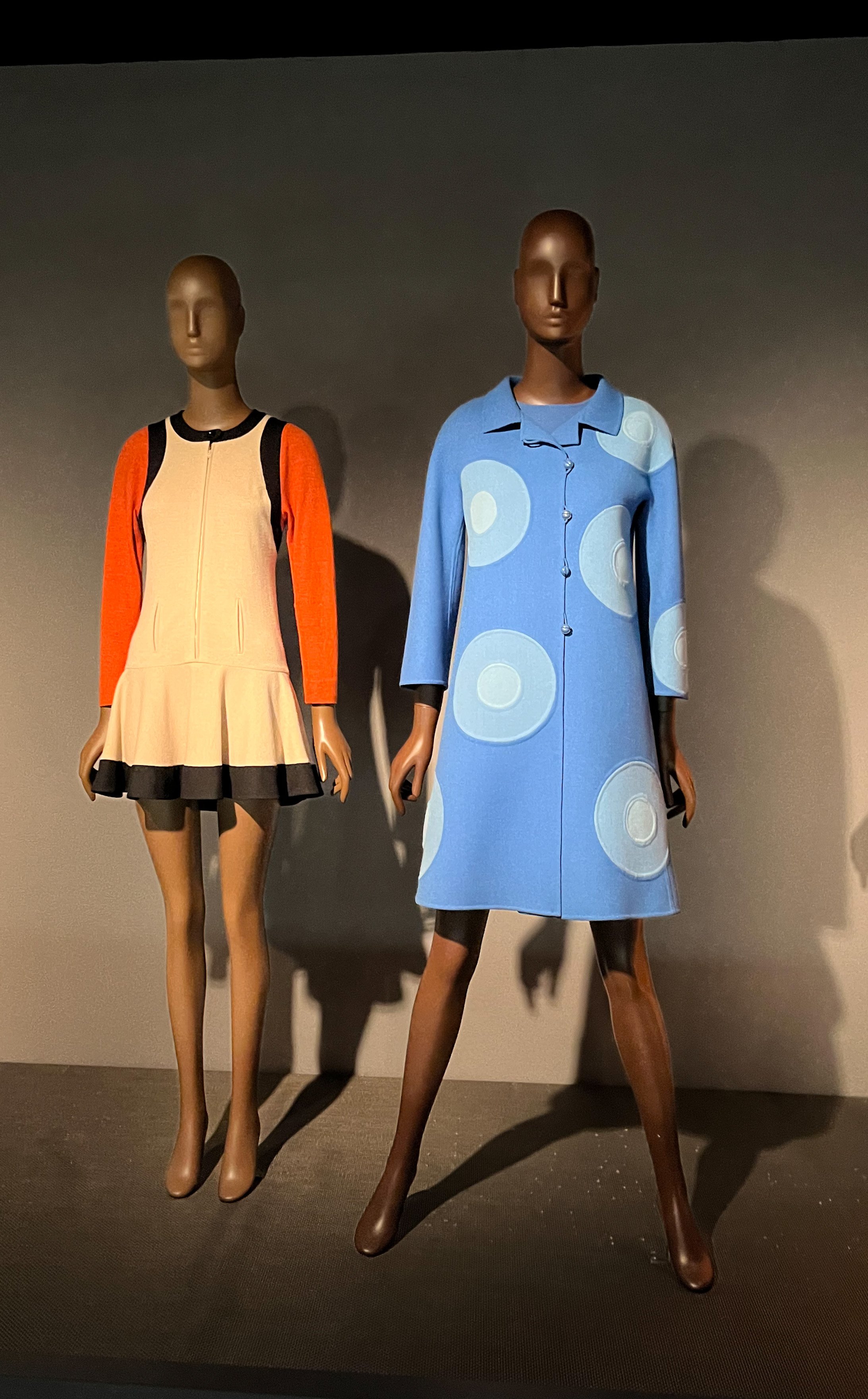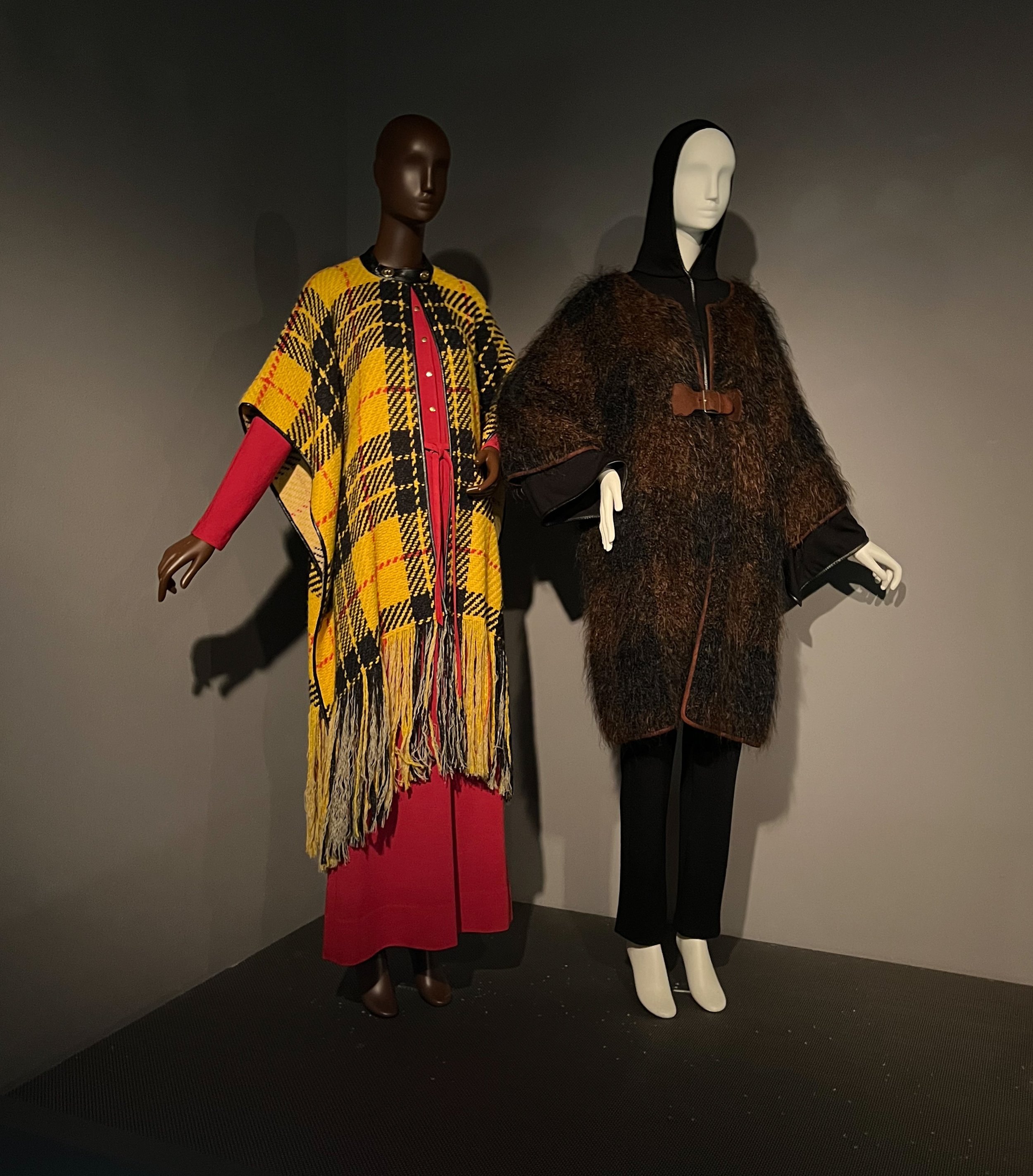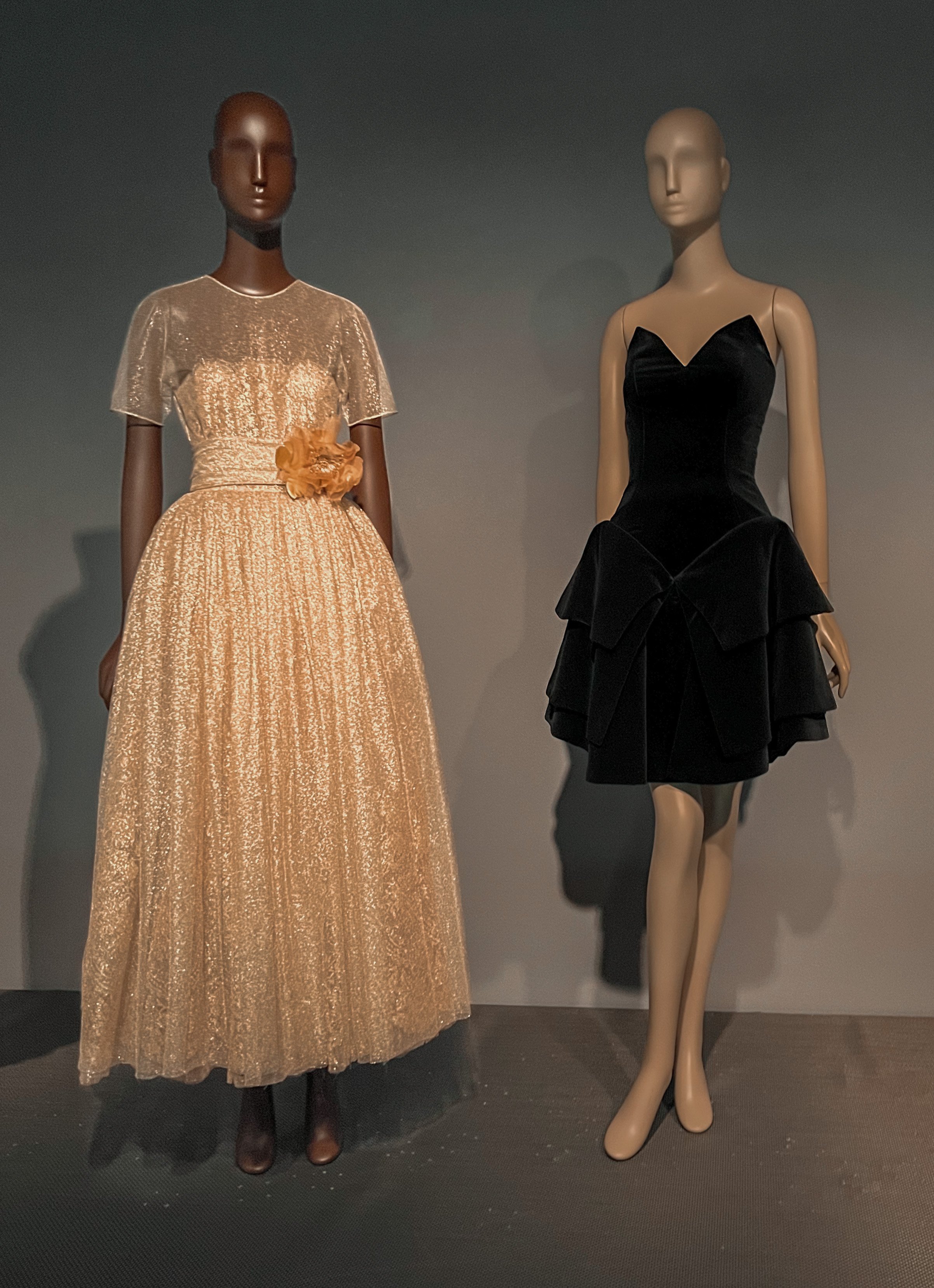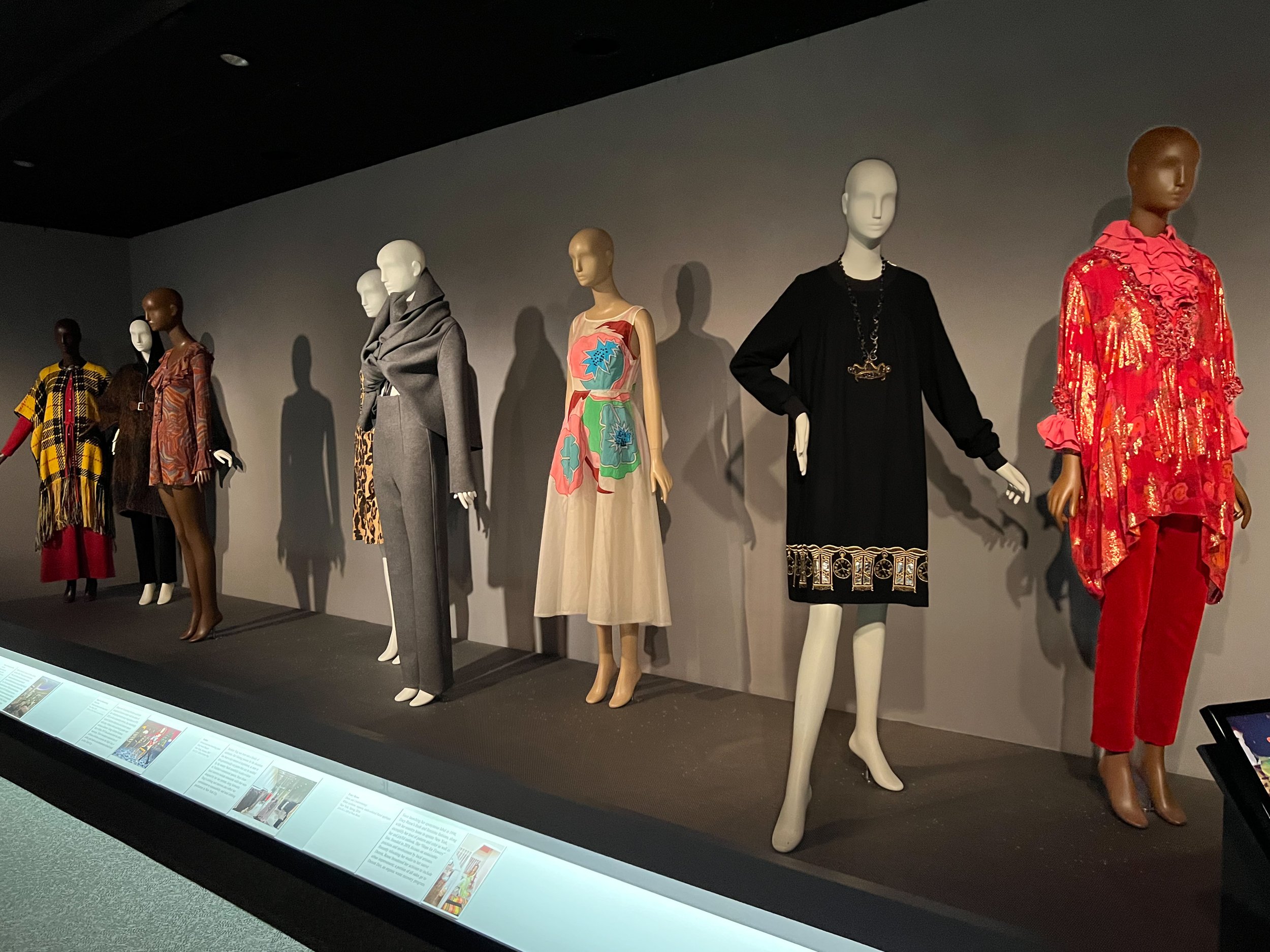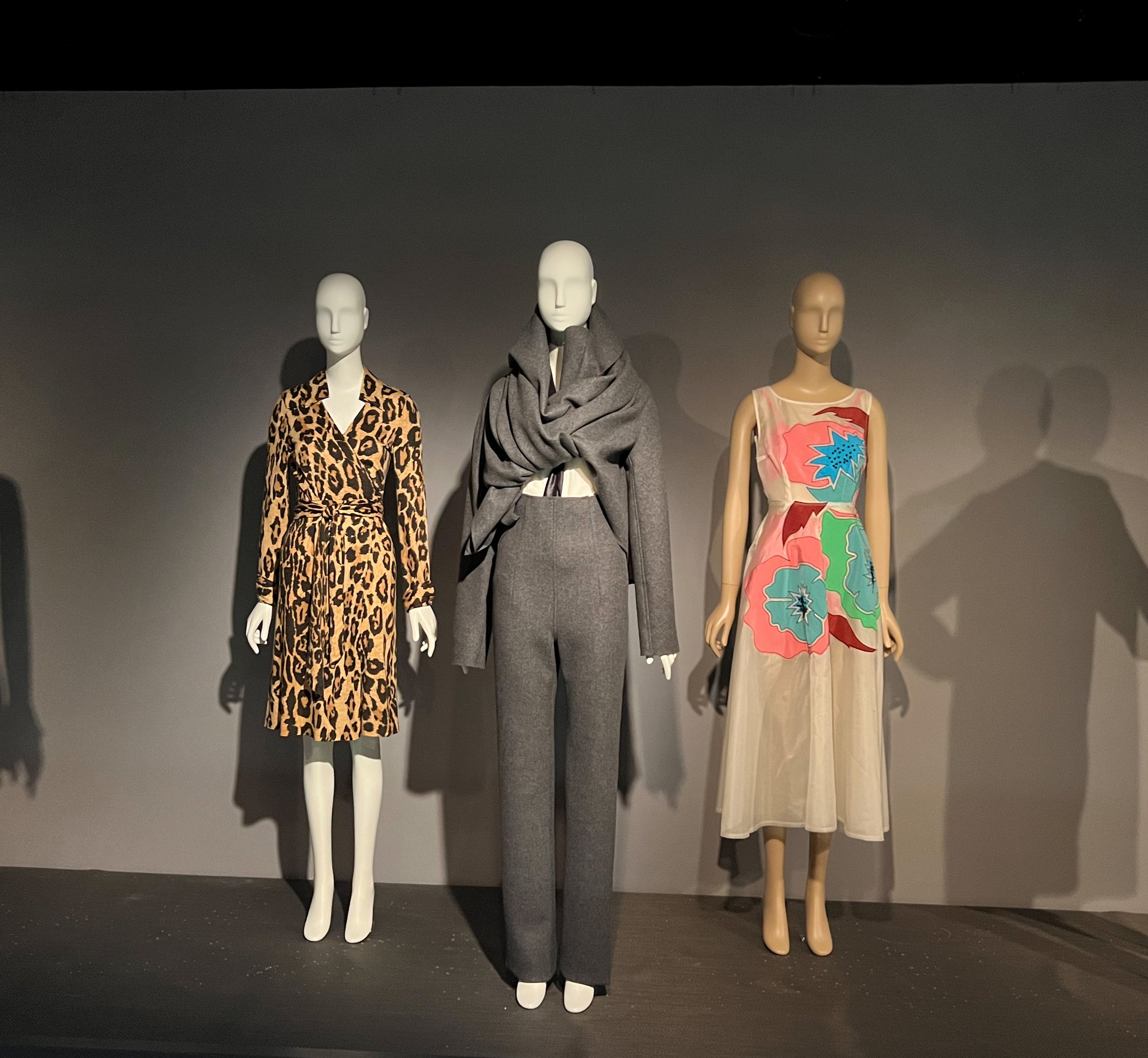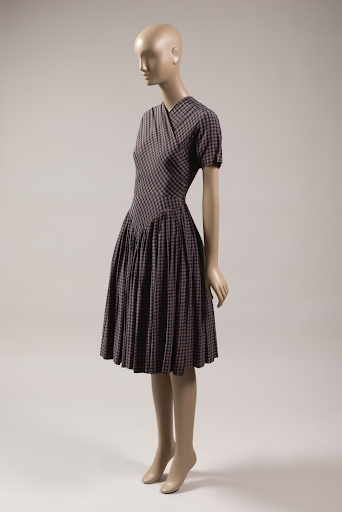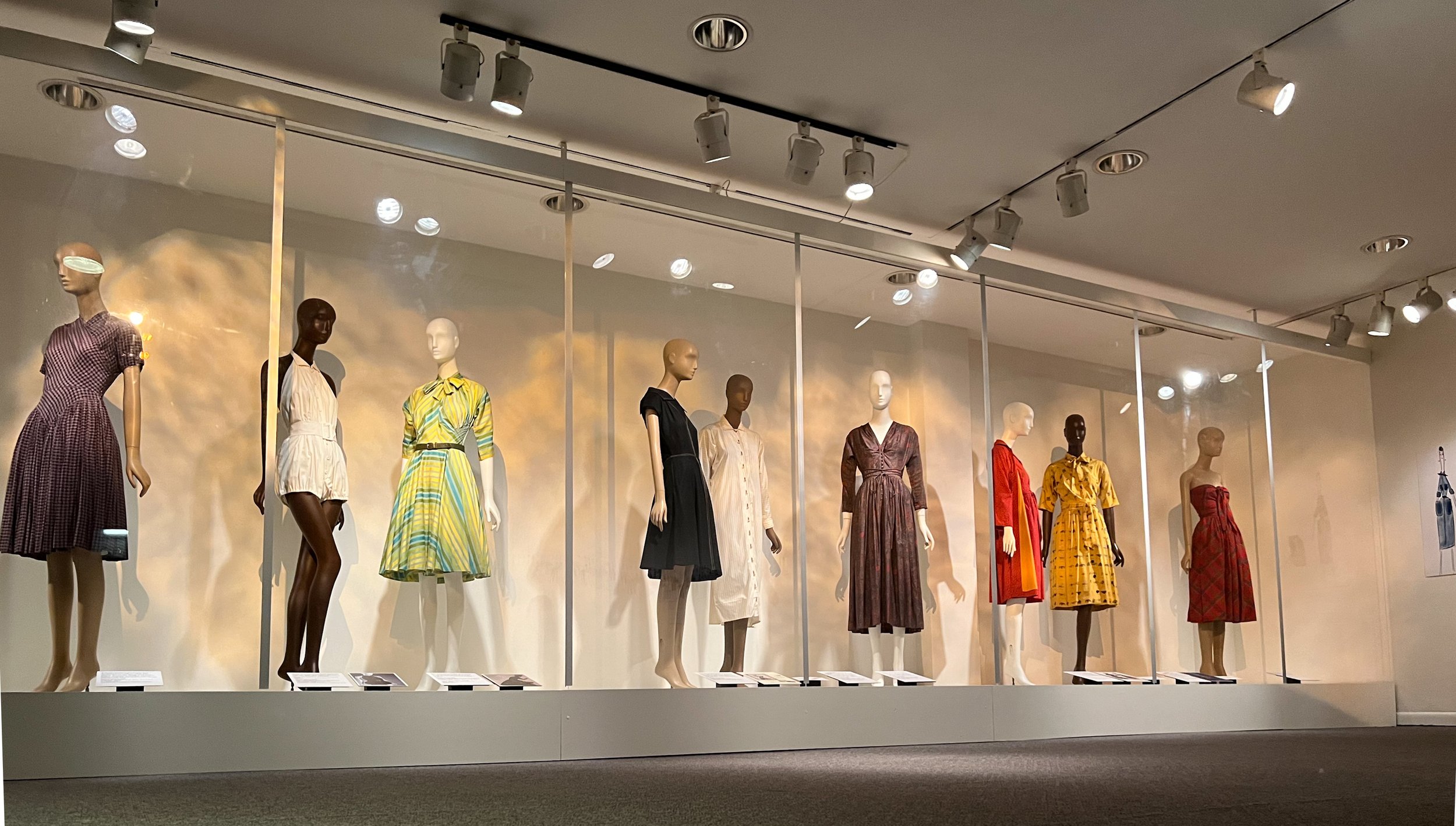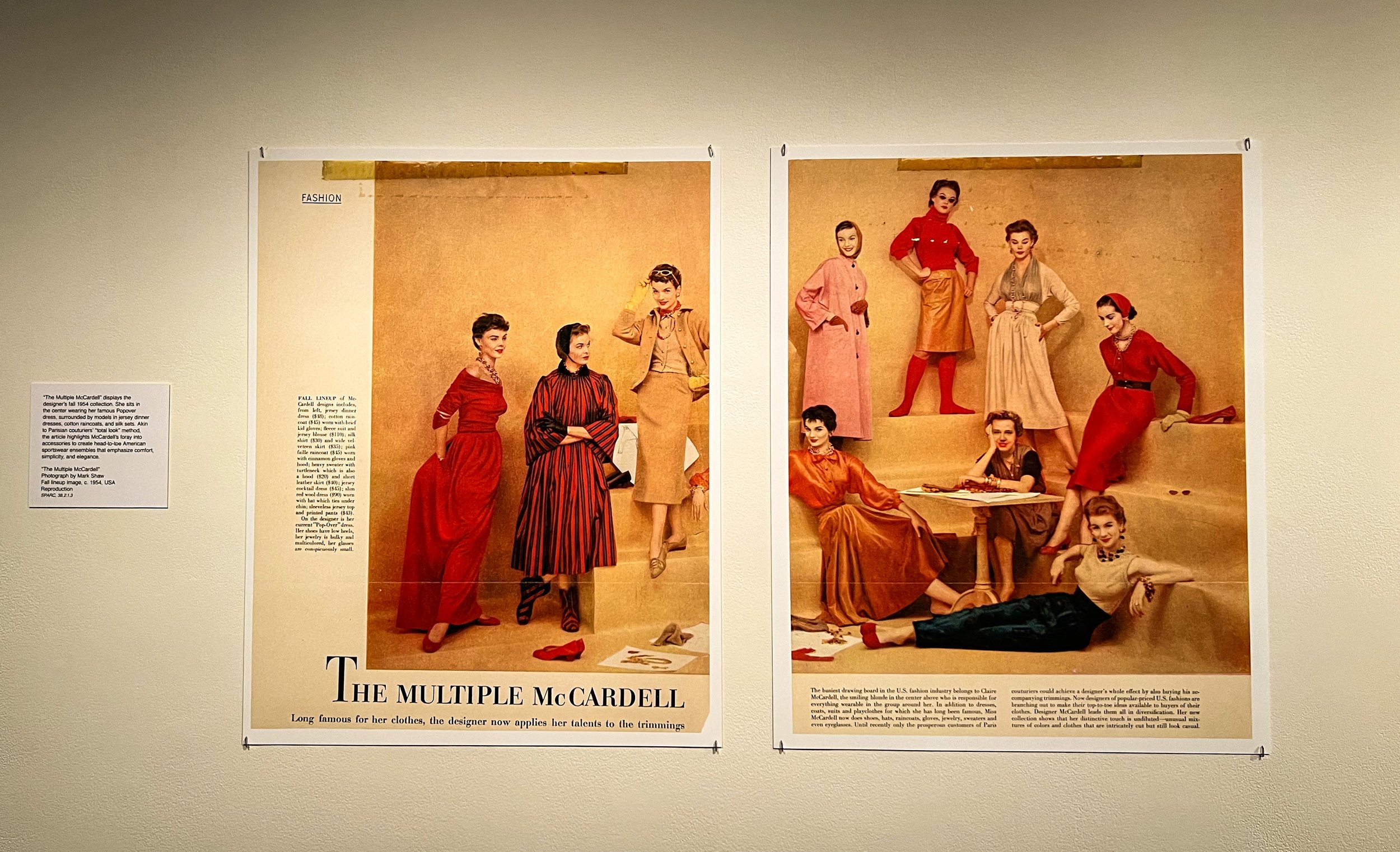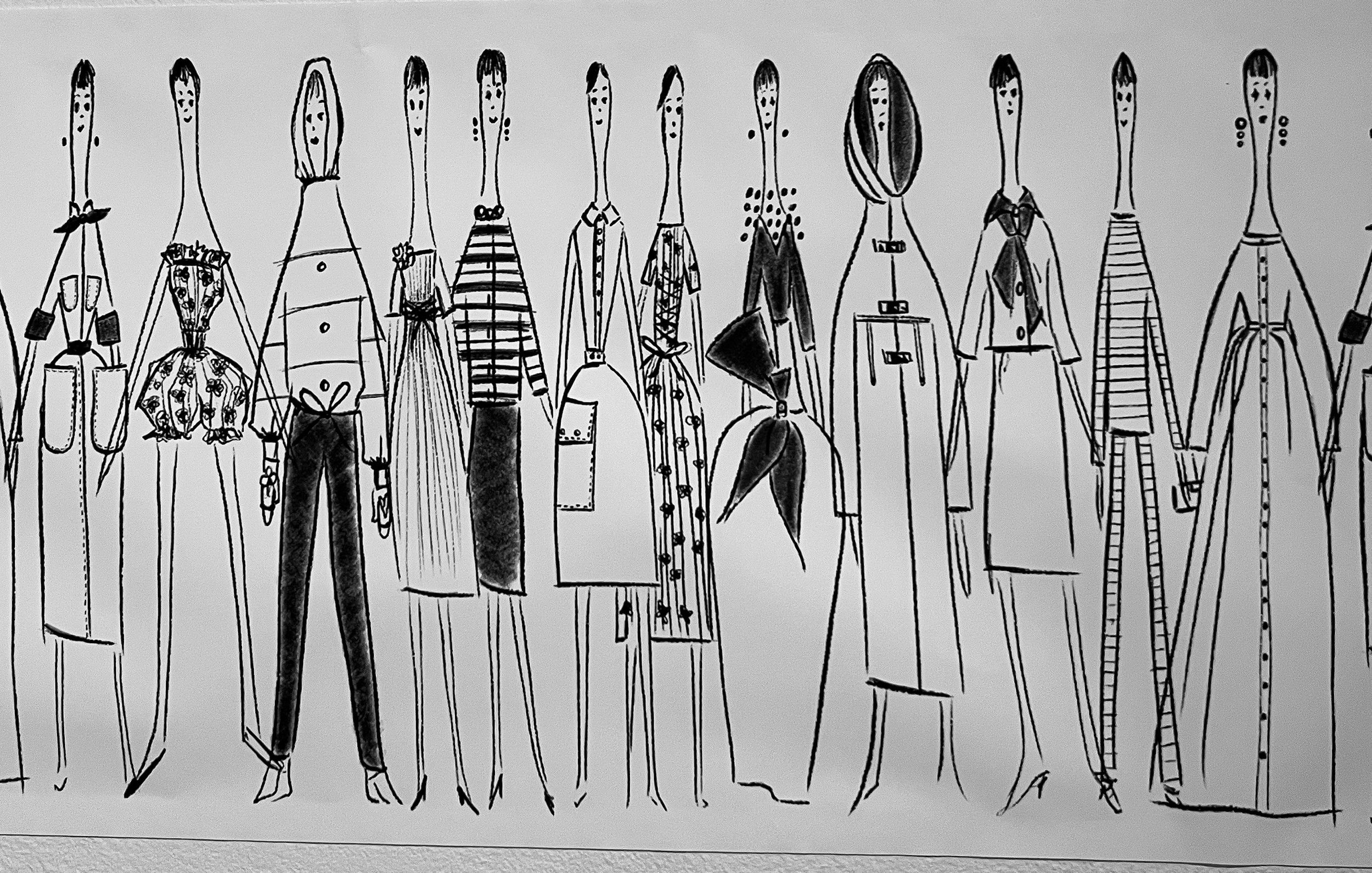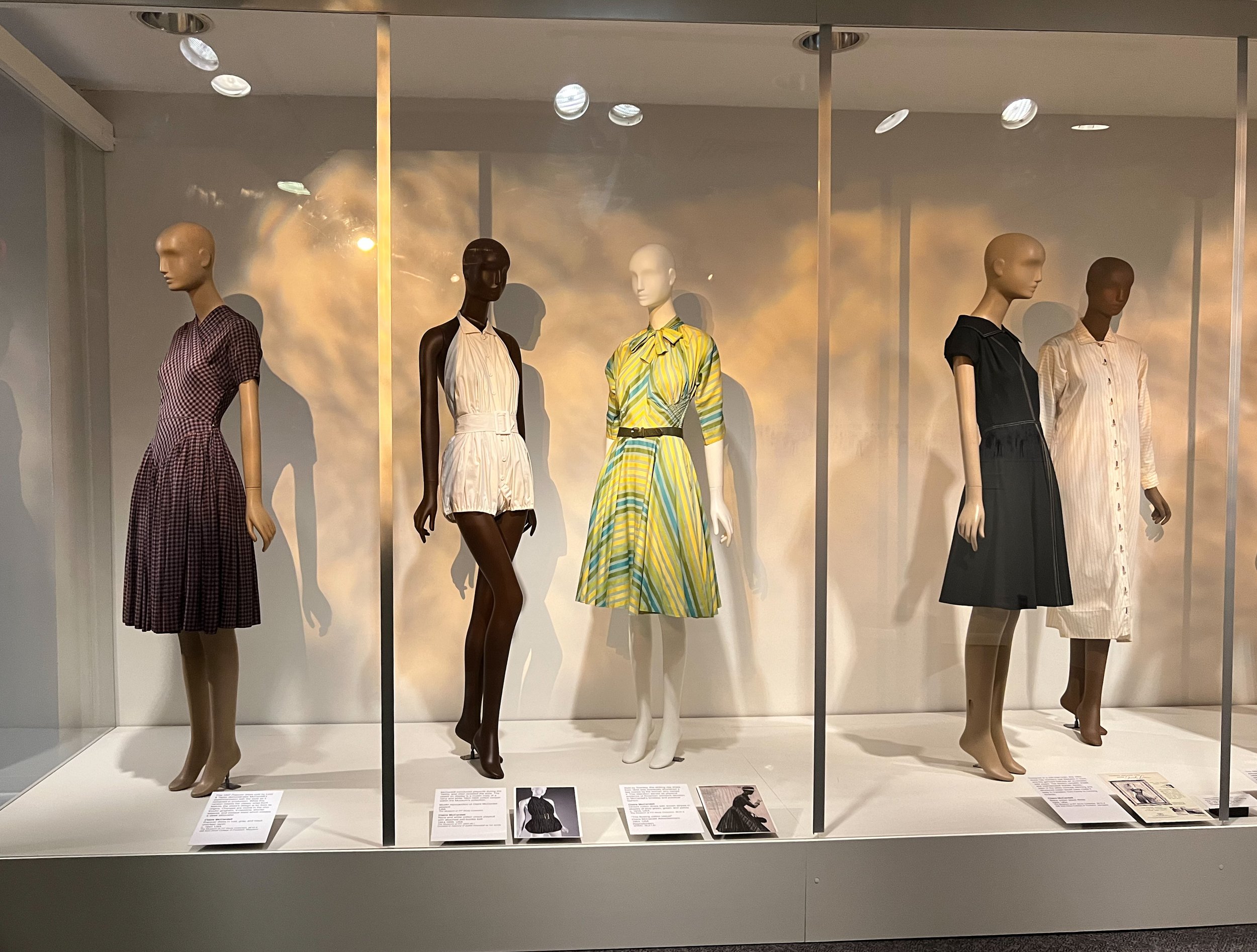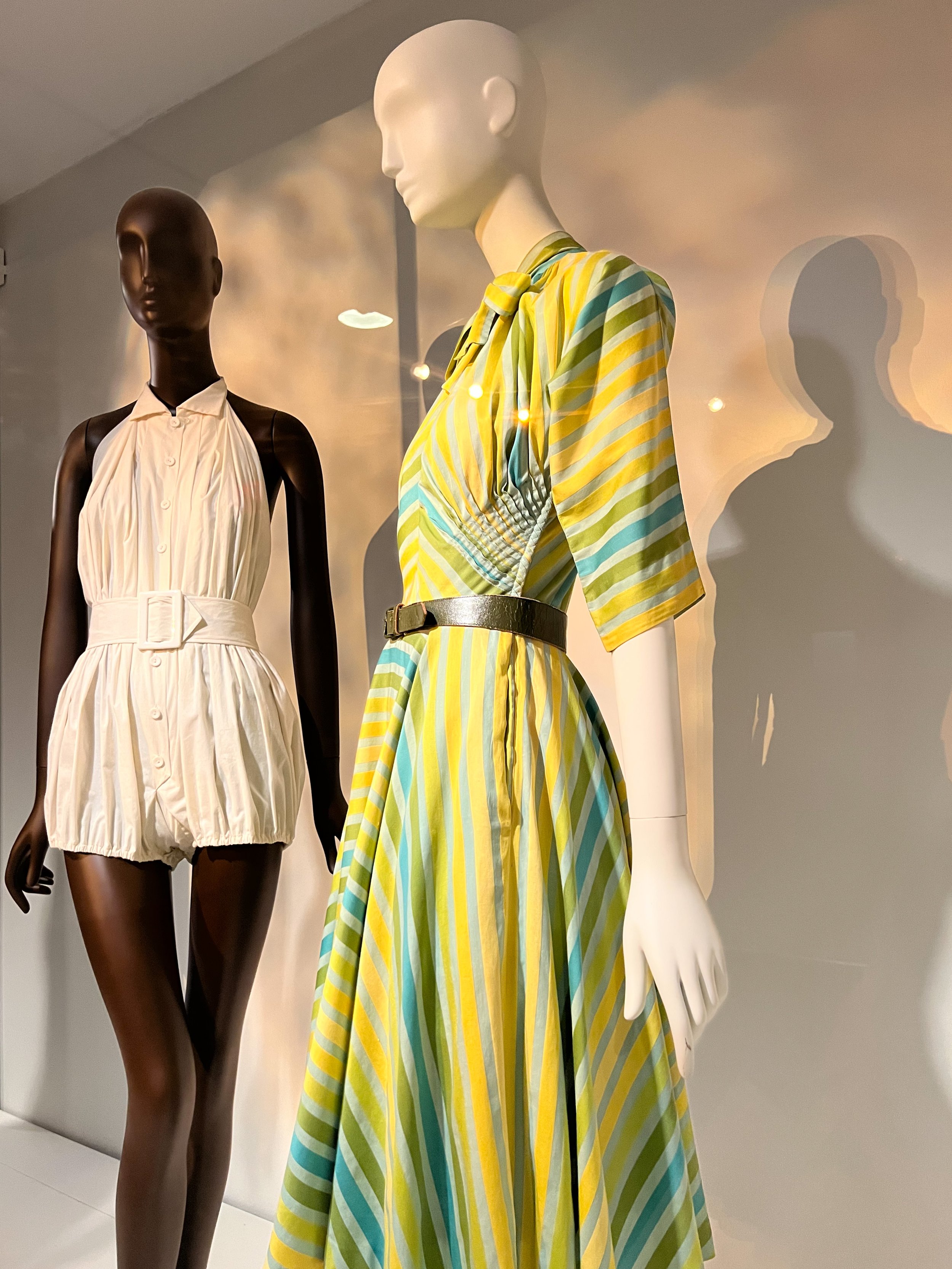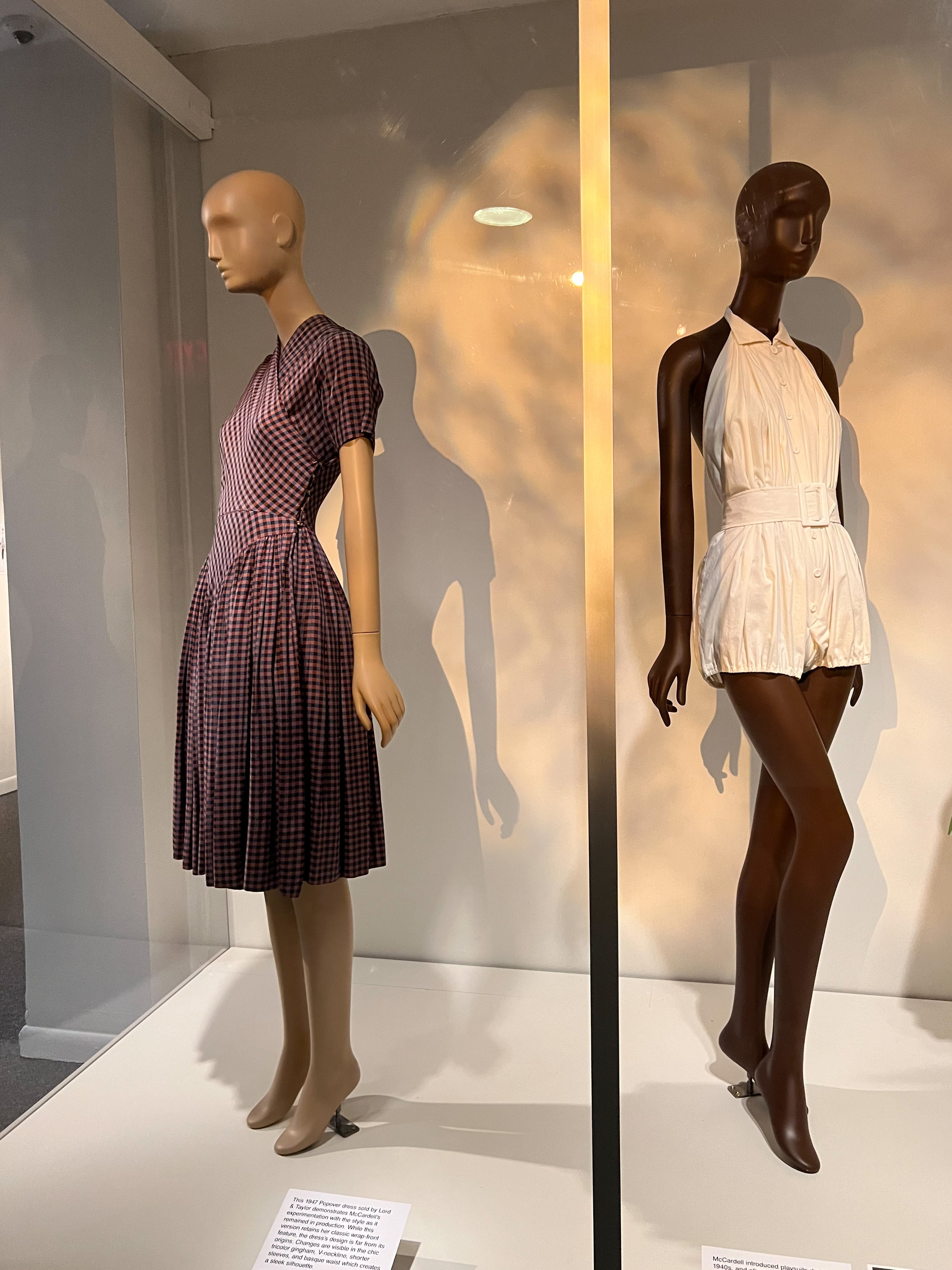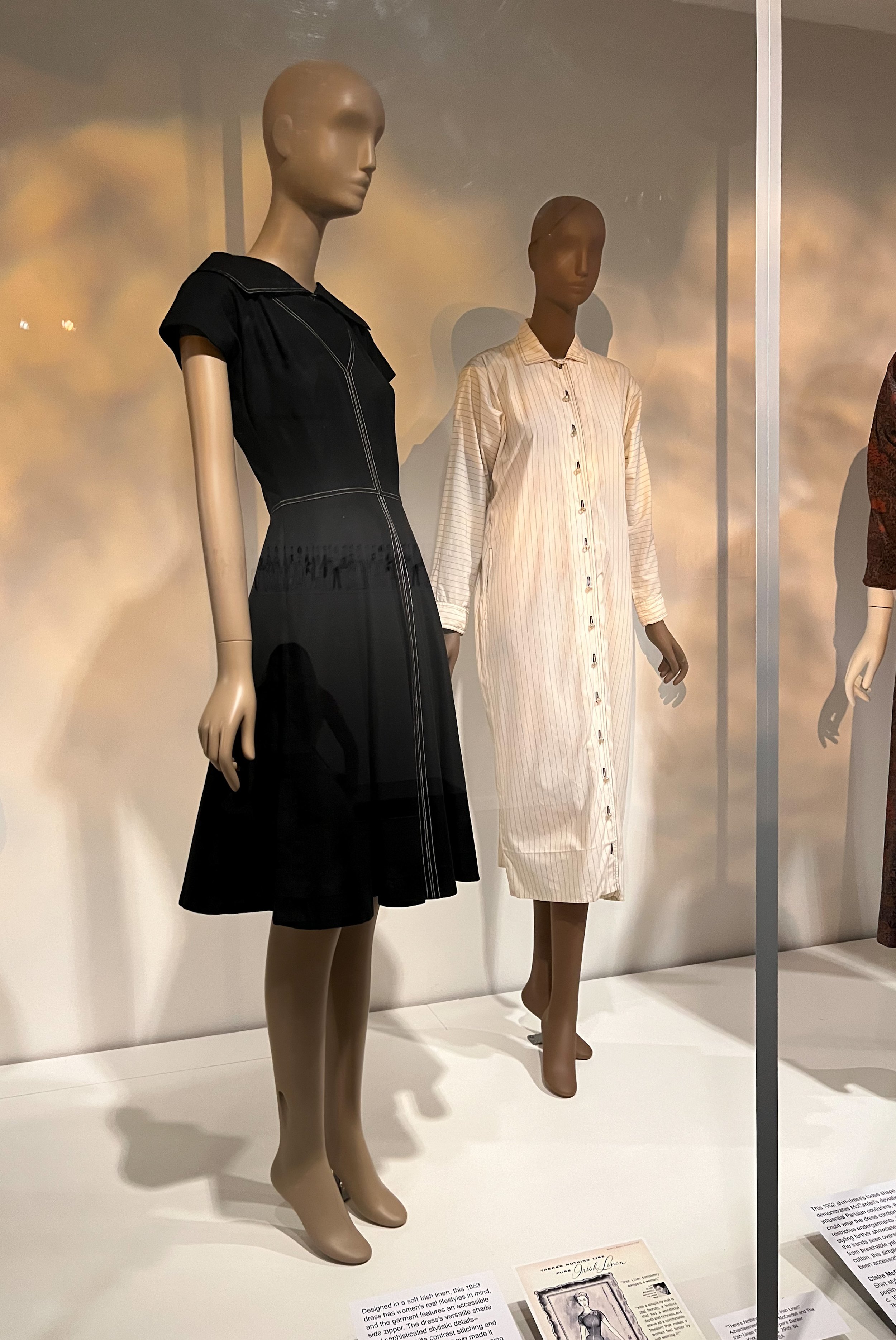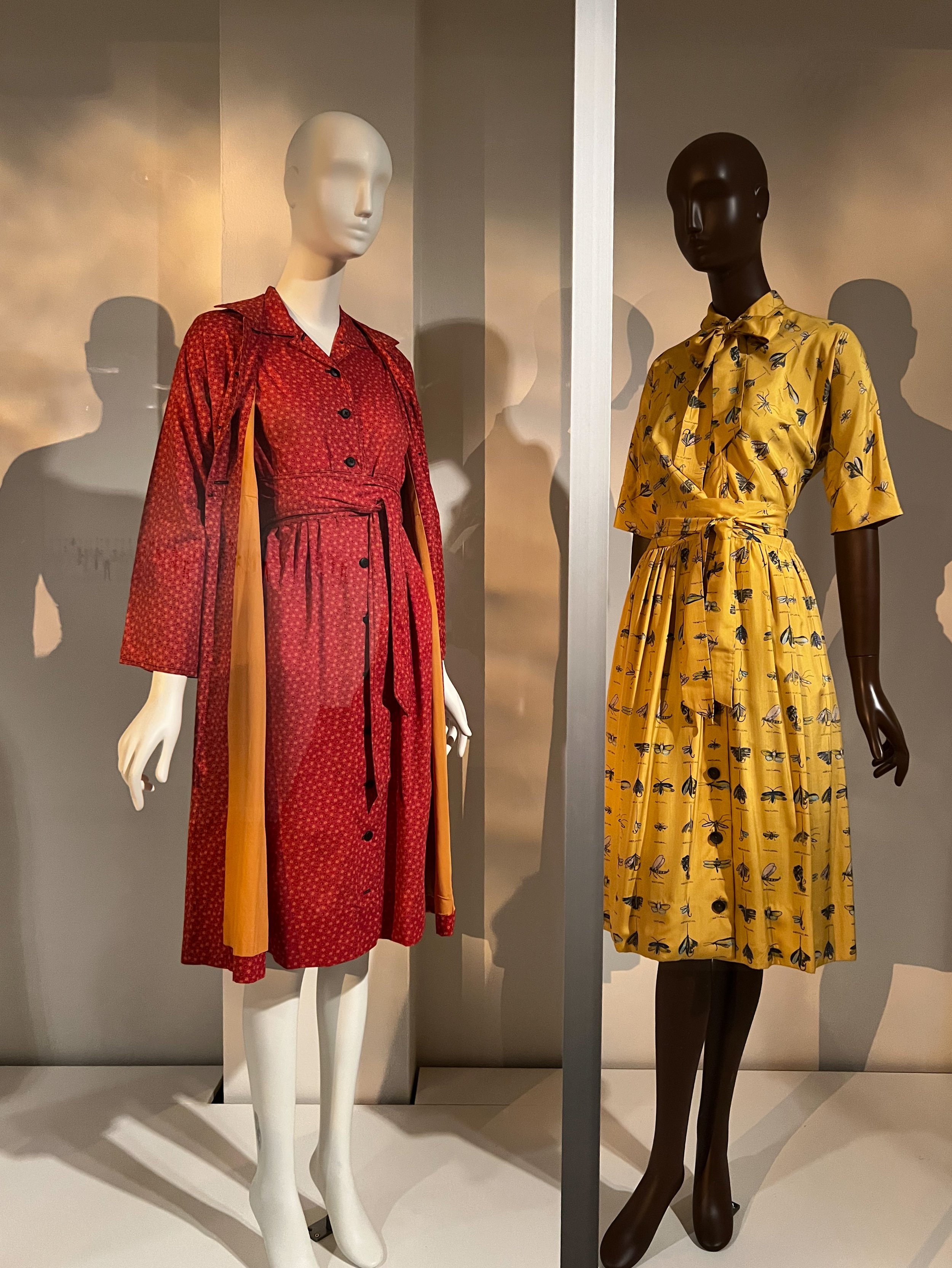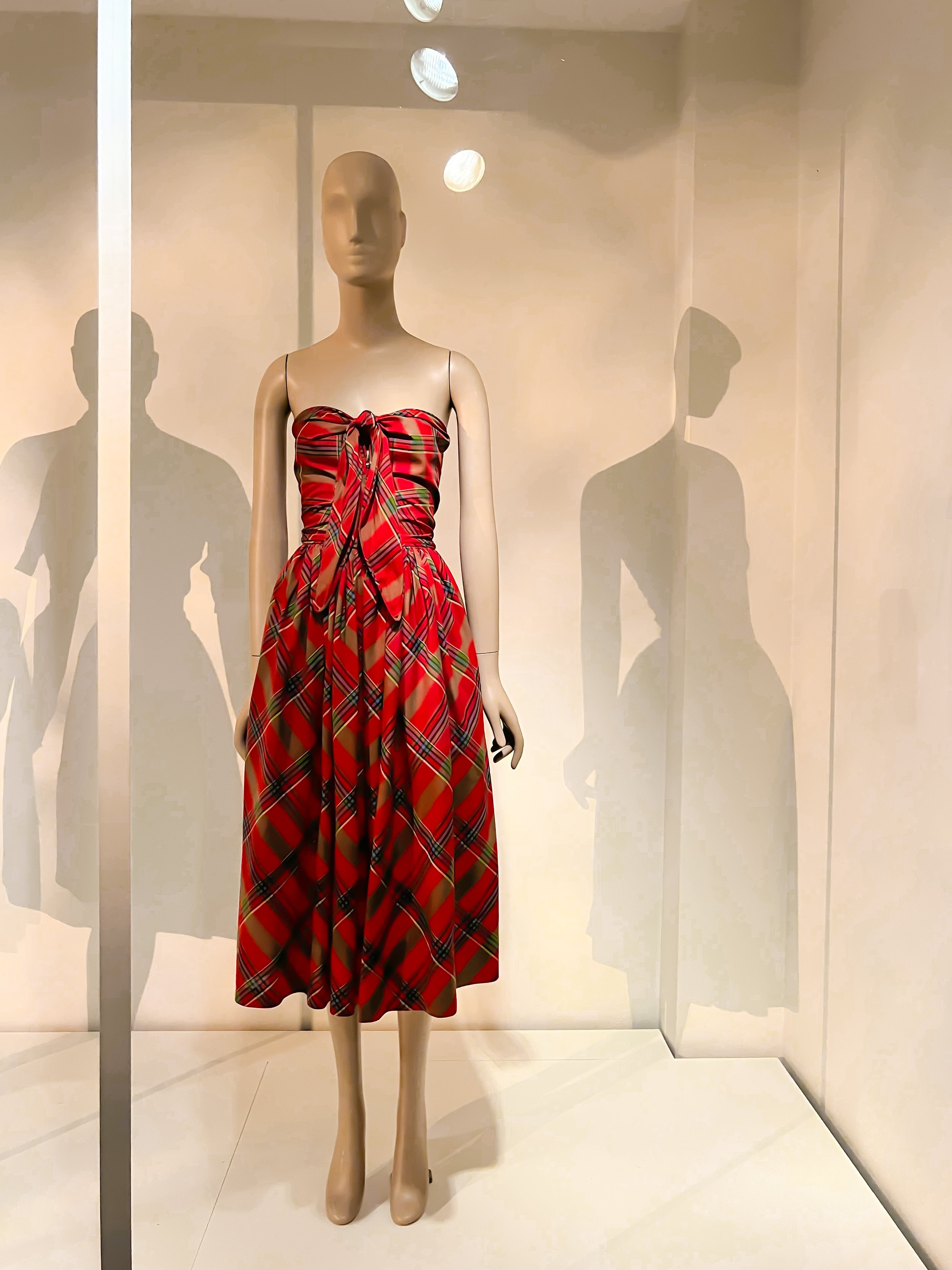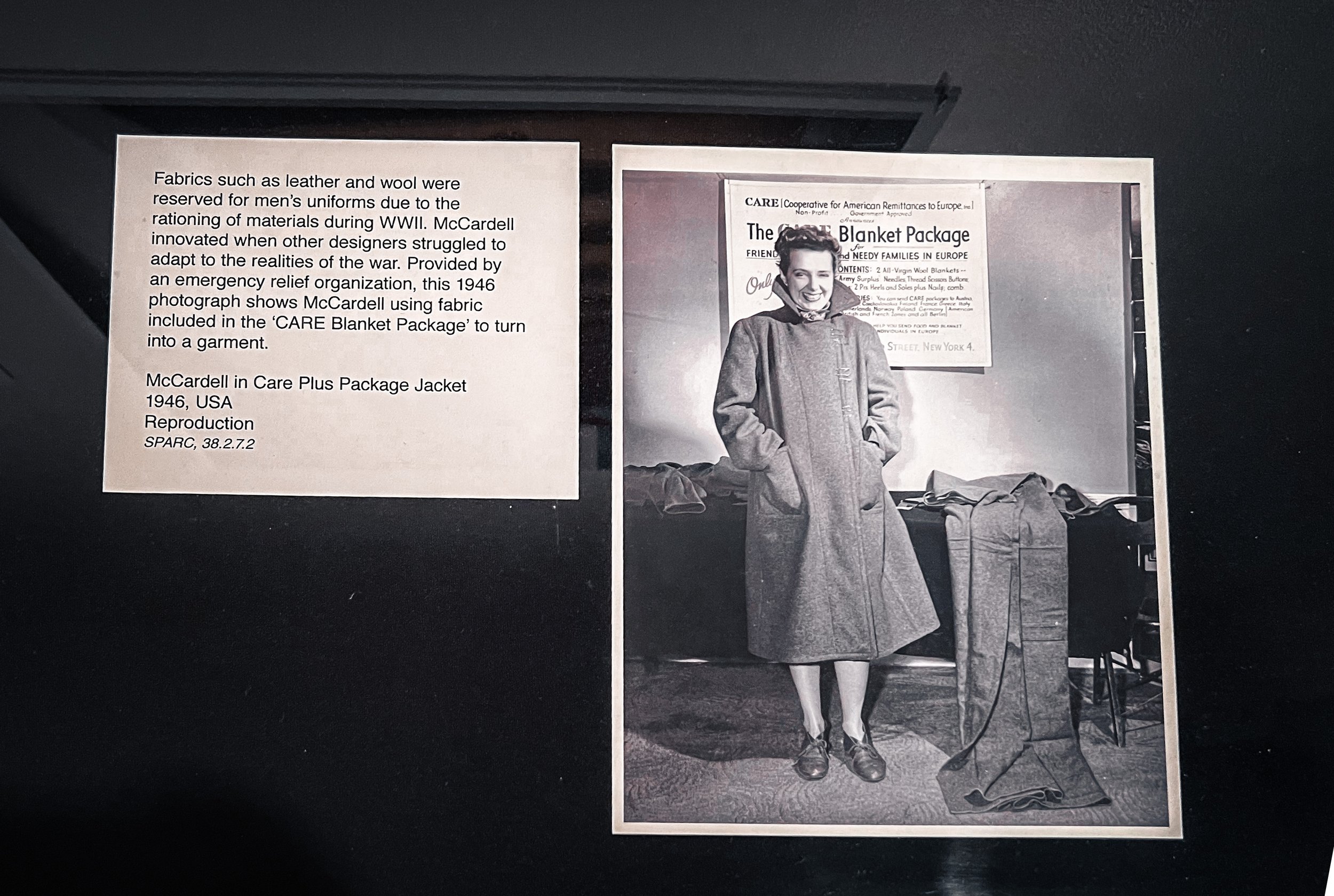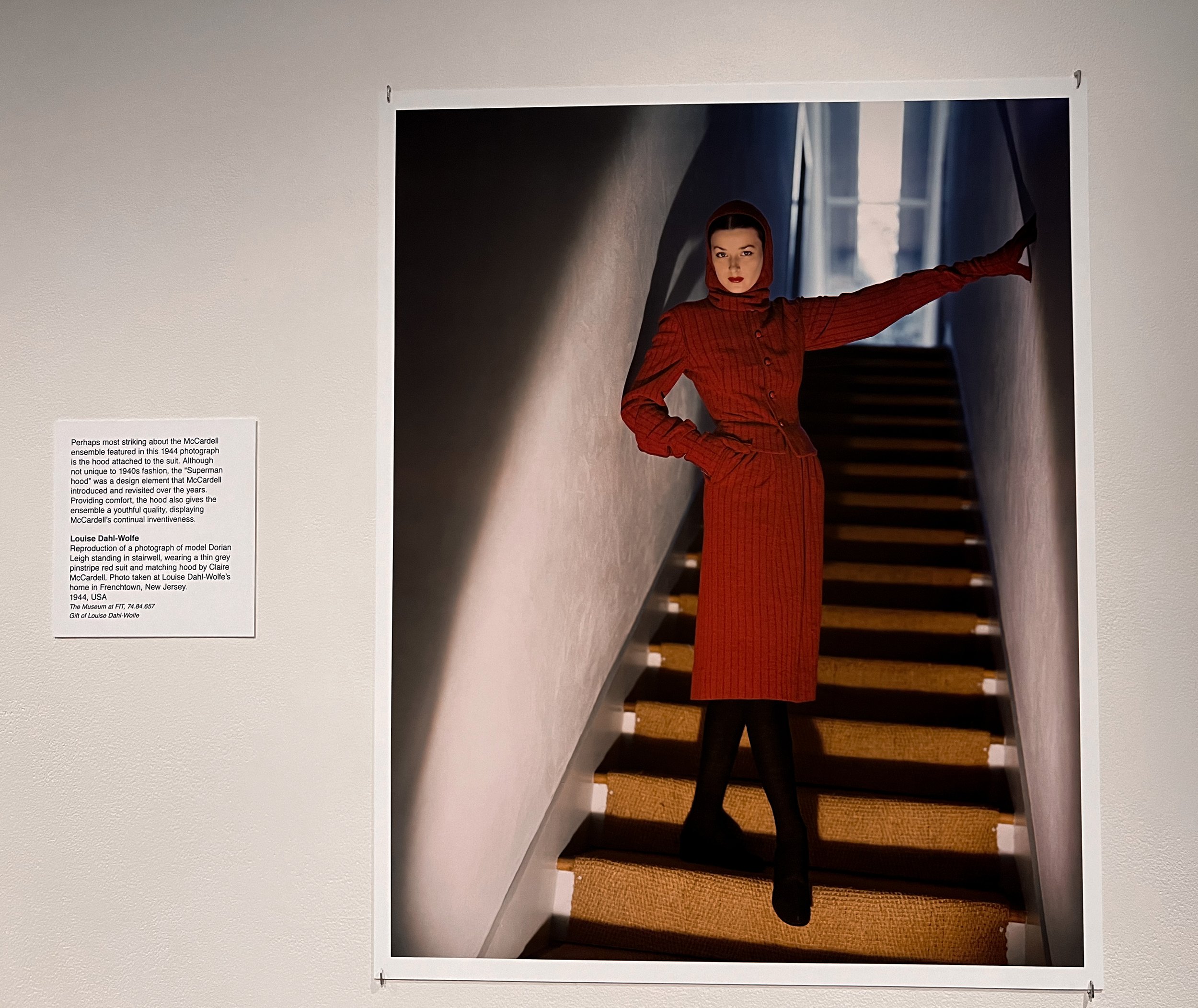"Sea Idylls": An Immersion into Hyperrealistic Sculpture and Feminine Power
Last week, as I was preparing for my trip to NYC, I had a conversation with a friend and asked her about some of her favorite must-see spots. She mentioned that one of her friends recently sent her a link to a new outdoor installation featuring the sculptures of Carole Feuerman. Since I used to design swimwear, she knew that this one would be interesting- and she was right!
New York City is known for its art, culture, and fashion. It’s no surprise that “Sea Idylls,” the latest art exhibition that graces Park Avenue, marries all three. The installation showcases Carole Feuerman’s stunning hyper realistic sculptures of women in swimwear. Her attention to detail is what sets her work apart, making this something worth seeing.
For Feuerman, these sculptures aren't just about the aesthetics of a bikini or the joy of a dip in the water. Instead, each piece is imbued with rich, often unspoken narratives, mirroring societal realities and universal human emotions. It just happens to be swimwear that she uses as a mechanism to tell the tale. This deep and rich exploration of themes makes her art that much more interesting and engaging. Let’s take a loser look, so you can more fully appreciate the intricacies of each piece.
Feuerman's sculptures are testaments to her extraordinary attention to detail. They possess a quality of hyperrealism that makes the viewer question the boundaries between art and life. With painstaking precision, she captures the texture of the fabric, the shimmer of water droplets on sun-kissed skin, and the palpable essence of a day spent by the seaside.
Another piece, "Survival of Serena", depicts a weary woman clinging to an inner tube. The sculpture, inspired by the sight of immigrants floating on water towards a hopeful future, encapsulates the struggles of immigrants and their relentless pursuit of a better life.
Perhaps one of the most interesting aspects of this exhibit is the collaboration between Feuerman and swimwear designer Sama Danesh. “Pisces” embodies the designer’s aesthetic and stands out due to Feuerman’s willingness to explore the work of another artist. As someone who used to make swimwear, this one definitely caught my eye. I was astounded by the play of textures and attention to detail. Do you see those seams?
As I walked down Park Avenue, I had to pause to truly appreciate these beautiful interludes of art, and found myself transported to a place of deep reflection and powerful narratives.
“Justice" is another particularly striking work that depicts a woman balanced atop a sphere, symbolizing her representation of justice throughout the land. The reflection of the sphere functions as a type of collective lens that invites the viewer to examine their place in the world and reflect on the disparity of experience.
Carole Feuerman's “Sea Idylls” exhibit is something you're going to want to see in person. It is an impressive collection that portrays women in swimwear in different perspectives, emphasizing strong narratives. You will come away with a deeper appreciation for the art form and the stories behind each piece. Do not miss this chance to experience this exhibition on Park Avenue until the end of the year.
To learn more about Feuerman’s work, you can download the Galeries Bartoux Digital catalogue.
Designing Women: Fashion Creators and Their Interiors
The recent exhibit at the Museum at FIT, Designing Women, Fashion Creators and their Interiors, beautifully captures the women behind the designs, her visions, her revolutions, her impact on the world and how her work influenced other women of their time– not in a prescriptive way, but rather by giving women new avenues for self-expression and empowerment. By pushing boundaries in both fashion and interior design, these designers expanded the realm of possibilities for women. By telling the story of the woman behind the designs, her visions, her revolutions, and her impact on the world – it shows how these women, through their work, transformed the spaces we live in and the clothes we wear.
Gowns attributed to Lucile, Lady Duff Gordon; at the Museum FIT exhibit: Designing Women: Fashion Creators and their Interiors
Designing Women: Fashion Creators and Their Interiors, a recent exhibit at the Museum at FIT, explores the interconnectedness of fashion and interior design through the lens of some of the most influential female designers of the 20th century. This exhibit was the second of five fashion exhibits that I saw while in NYC last month. Recently, I wrote about the student curated, Claire McCardell exhibit.
Fashion at its essence is a form of communication. Through it, we can express our identity, ideas, and aspirations. Since fashion reflects the cultural, political, and socio-economic context of a given period, this exhibit provides an opportunity to see how fashion influenced the creative process of some extraordinary twentieth-century fashion creators. While also inspiring a profound appreciation for the artistry and environmental influences that helped to shape their careers.
Gowns attributed to Lucile, Lady Duff Gordon and the Callot Sisters at the Museum FIT exhibit: Designing Women: Fashion Creators and their Interiors
Gowns by Jeanne Pauquin, at the Museum FIT exhibit: Designing Women: Fashion Creators and their Interiors
Understanding the Influence of 20th Century Women Designers
More than just a celebration of fashion, Designing Women, is an exploration of the creative process that reveals how fashion and design are used as a canvas to express views on femininity, comfort, luxury, and even rebellion. By challenging societal norms, the bold and pioneering clothing and interiors, redefined what fashion could be. Transforming not just the way women dressed, but also the way they lived.
You can see this duality in the work of Coco Chanel, for example. An icon of sophisticated simplicity, she prioritized comfort in her designs, while pioneering a new aesthetic of elegance that placed the modern woman at its core. Her Parisian apartment, with its neutral colors, exquisite minimalism, and mix of masculine and feminine elements, echoed the same philosophy. It portrayed luxury in the realm of comfort, serving as a physical extension of her avant-garde vision for women's fashion.
Coco Chanel, and Elsa Schaiparelli (right) at the Museum FIT exhibit: Designing Women: Fashion Creators and their Interiors
Detail Chanel Black Lace Evening Dress, C. 1932
Madeleine Vionnet, Schaiparelli, and Chanel dresses,
Chanel’s work was juxtaposed with designers such as Madeleine Vionnet, Jeanne Paquin, Elizabeth Hawes, Bonnie Cashin, Anna Sui, and Elsa Schiaparelli. Schiaparelli’s home, with its whimsical and provocative elements, was such a reflection of her Surrealist leanings. Underscoring how each woman's living space and their sartorial creations are truly an extension of their fashion ethos.
Placed within the broader historical context of the twentieth century, the curator, Deputy Director, Patricia Mears has skillfully incorporated the prevailing social, cultural, and artistic movements of the time, enabling visitors to better understand the designers' motivations, inspirations, and the impact their work had on society. This historical framework serves as a valuable backdrop, enhancing our appreciation for the transformative power of design and how it shaped the spaces we live in and the clothes we wear today.
As I meandered through the gallery, I could more fully appreciate how the personal philosophies of the designers became intrinsically woven into their work, and how their interiors were both a reflection and an extension of their personal styles. Not as separate spheres of private and public, fashion and interiors, but as a single canvas of personal expression for their revolutionary ideas. With each vignette, I looked for parallels and differences, for echoes and deviations. Remembering that each of these women was not only creating beautiful clothing, but also a new paradigm for women in their time.
Exploring Fashion and Interior Design
I often encourage my fashion students to go to museums and to look beyond the visual aesthetics and to think about the cultural, social, and historical context. To engage with the exhibition not just as an observer, but as a student of history and culture. Above all, I ask them to remember, every designer leaves a bit of herself in her work. Our job is to find and understand it.
Pauline Trigère, Mary Quant, Mila Schoën, Irene Galitzine, and Halston with Elsa Peretti “Bone” cuffs and “Bottle Open Bottle” Necklace.
Mary Quant and Mila Schön
Bonnie Cashin ensembles.
Gowns by Anouska Hemple and Carolyne Roehm.
Bonnie Cashin, Barbara Hulanicki for Biba, Diane von Furstenberg, Yeohlee, Tracy Reese, Anna Sui.
Diane von Furstenberg, Yeohlee, and Tracy Reese.
How Designing Women Transformed Fashion and Interior Design
Drawn from the Museum at FIT’s permanent collection, this exhibit beautifully captures the women behind the designs, her visions, her revolutions, her impact on the world and how her work influenced other women of their time– not in a prescriptive way, but rather by giving women new avenues for self-expression and empowerment. By pushing boundaries in both fashion and interior design, these designers expanded the realm of possibilities for women. By telling the story of the woman behind the designs, her visions, her revolutions, and her impact on the world – it shows how these women, through their work, transformed the spaces we live in and the clothes we wear.
I left with a renewed understanding of the transformative power of fashion, the significance of personal spaces, and the enduring legacies of these influential women. Designing Women is not only a celebration of their accomplishments but also a testament to the ongoing dialogue between fashion, art, and the spaces in which creativity flourishes. By highlighting these intertwined narratives, the exhibit encourages viewers to think more deeply about the cultural and historical contexts that these designers navigated, thus providing a comprehensive understanding of their contributions.
/\/\/\/\/\/\/\/\/\/\/\/
Hilarie
Designing Women: Fashion Creators and Their Interiors
At the Museum at FIT, November 30, 2022- May 14, 2023
Claire McCardell Exhibition at FIT: Exploring Fashion's Pioneer
In the world of fashion, certain designers leave an indelible mark on the industry, shaping trends and redefining the way we dress. One such visionary is Claire McCardell, whose groundbreaking designs continue to inspire and captivate fashion enthusiasts even today. In April, I was able to see a captivating exhibition celebrating the remarkable legacy of Claire McCardell, at the Museum at the Fashion Institute of Technology (FIT): Claire McCardell, Practicality Liberation, Innovation. This small exhibit showcased some of her revolutionary designs while highlighting her enduring influence on contemporary fashion.
Claire McCardell
Practicality, Liberation, Innovation
Claire McCardell, Popover dress, rayon, brass hooks & eyes, c. 1947, Lord & Taylor, American, founded 1826, Gift from Hood College of Frederick, Maryland, 96.61.6
In the world of fashion, certain designers leave an indelible mark on the industry, shaping trends and redefining the way we dress. One such visionary is Claire McCardell, whose groundbreaking designs continue to inspire and captivate fashion enthusiasts even today. In April, I was able to see a captivating exhibition celebrating the remarkable legacy of Claire McCardell, at the Museum at the Fashion Institute of Technology (FIT): Claire McCardell, Practicality Liberation, Innovation. This small exhibit showcased some of her revolutionary designs while highlighting her enduring influence on contemporary fashion.
As a lifelong McCardell fan, the is the second exhibit of her work that I have seen in six months. Before then, it had been about 30 years. Needless to say, I was thrilled.
A Pioneer in American Fashion:
Claire McCardell, born in 1905, emerged as a pivotal figure in American fashion during the mid-20th century. Known for her avant-garde approach to design, McCardell challenged conventional norms by prioritizing comfort, practicality, and freedom of movement in her garments. She played a significant role in shaping the modern concept of American sportswear, which emphasized simplicity, functionality, and wearability.
The exhibition was organized by four college seniors in the undergraduate program in Art History and Museum Professions (AHMP Program) at FIT. The garments showcased, are culled from the FIT Study Collection, with additional historical records from the Gladys Marcus Library’s Special Collection & College Archives.
Organized into three sections, Practicality Liberation and Innovation, this exhibit offers visitors a unique opportunity to witness the evolution of McCardell’s career and gain insights into her creative process. The curation captures McCardell's distinctive style, highlighting her groundbreaking use of fabric, innovative garment construction techniques, and keen eye for detail.
McCardell's designs were characterized by their clean lines, unstructured silhouettes, and inventive use of fabrics such as denim, menswear suiting woolens, and cotton. She introduced several innovative design elements that are now considered industry standards. For instance, the use of unique closures, such as grommets and hooks and eyes, spaghetti string ties and well-proportioned pockets are all McCardell-isms. The ballet flat as a shoe style, now a staple in every woman's wardrobe, can be traced back to McCardell's ingenious creations. She also popularized the concept of mix-and-match separates, allowing women to effortlessly combine different pieces to create versatile outfits.
Challenging Norms and Promoting Individuality: McCardell's designs not only prioritized comfort and practicality but also challenged societal norms, encouraging individuality and self-expression. She designed clothing that catered to the changing needs of women, both in domestic and public spheres, and even adhered to war rationing guidelines. By liberating women from cumbersome and restrictive clothing, McCardell truly transformed the fashion landscape. Her emphasis on functionality and ease of wear continues to resonate with modern designers, ensuring her lasting influence.
Below is a gallery of images of the garments.
Beyond showcasing McCardell's designs, the exhibition walls and tables were lined with reproductions of photographs as well as advertisements, flyers, newspaper clippings and letters to place the social and cultural context in which her work emerged. Visitors were encouraged to contemplate the impact of World War II on fashion and witness how McCardell's designs responded to the era's challenges, embracing a sense of optimism and liberation.
Claire McCardell's trailblazing designs serve as a source of inspiration for students, designers and enthusiasts alike. Her ability to bridge the gap between high fashion and practicality continues to influence contemporary fashion, encouraging the exploration of innovative techniques and the creation of garments that empower individuals to express their unique style.
The Claire McCardell exhibition at the Museum at FIT is a testament to the enduring legacy of this remarkable designer. Her contributions to American fashion, her innovative design philosophy, and her unwavering commitment to creating comfortable yet stylish clothing continue to inspire and captivate fashion enthusiasts and designers alike. Exploring the exhibition provides a glimpse into McCardell's revolutionary designs and the profound impact she had on shaping the fashion industry. Claire McCardell's remarkable vision serves as a reminder that fashion can transcend trends and that timeless design can continue to shape and influence the way we dress for generations to come.
/\/\/\/\/\/\/\/\/\/\/\/
Hilarie
To see more photos, follow the hashtag on social media. #clairemccardellMFIT
